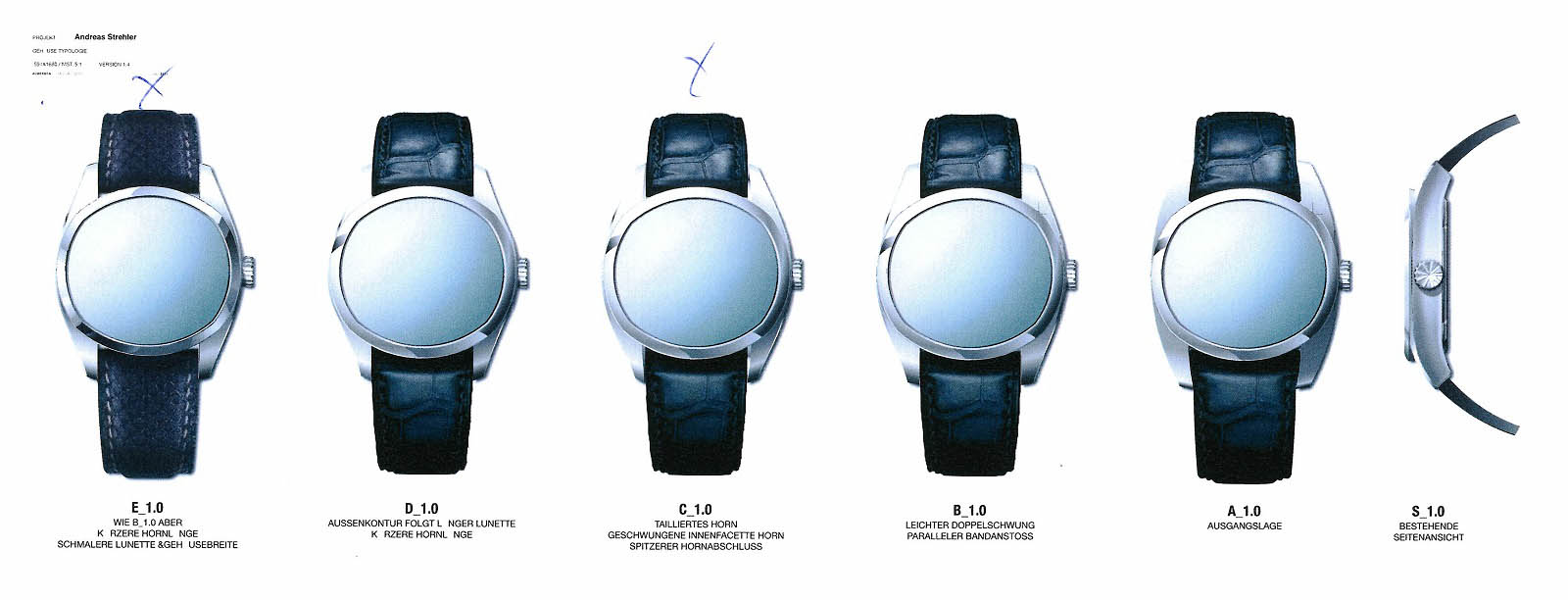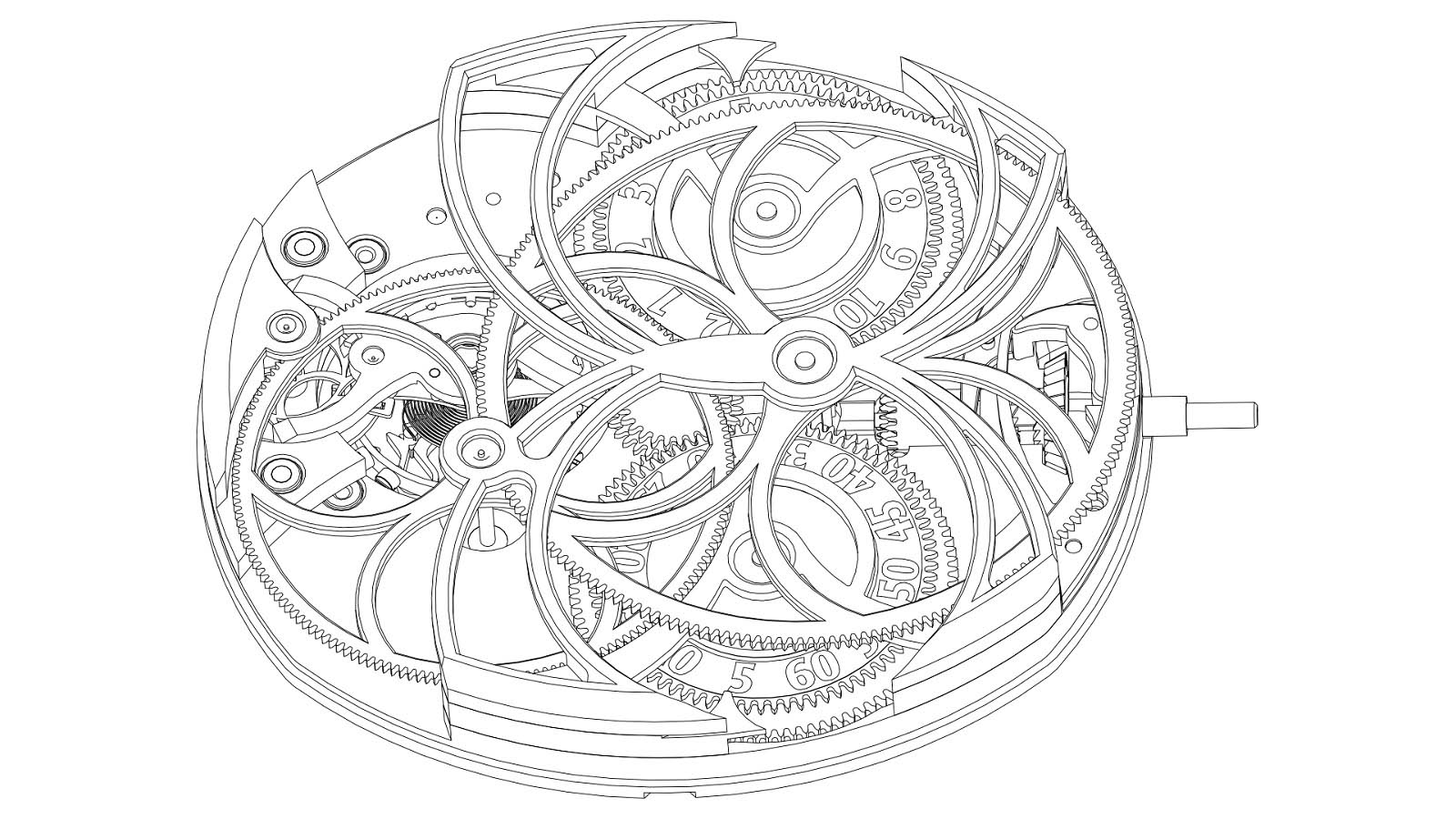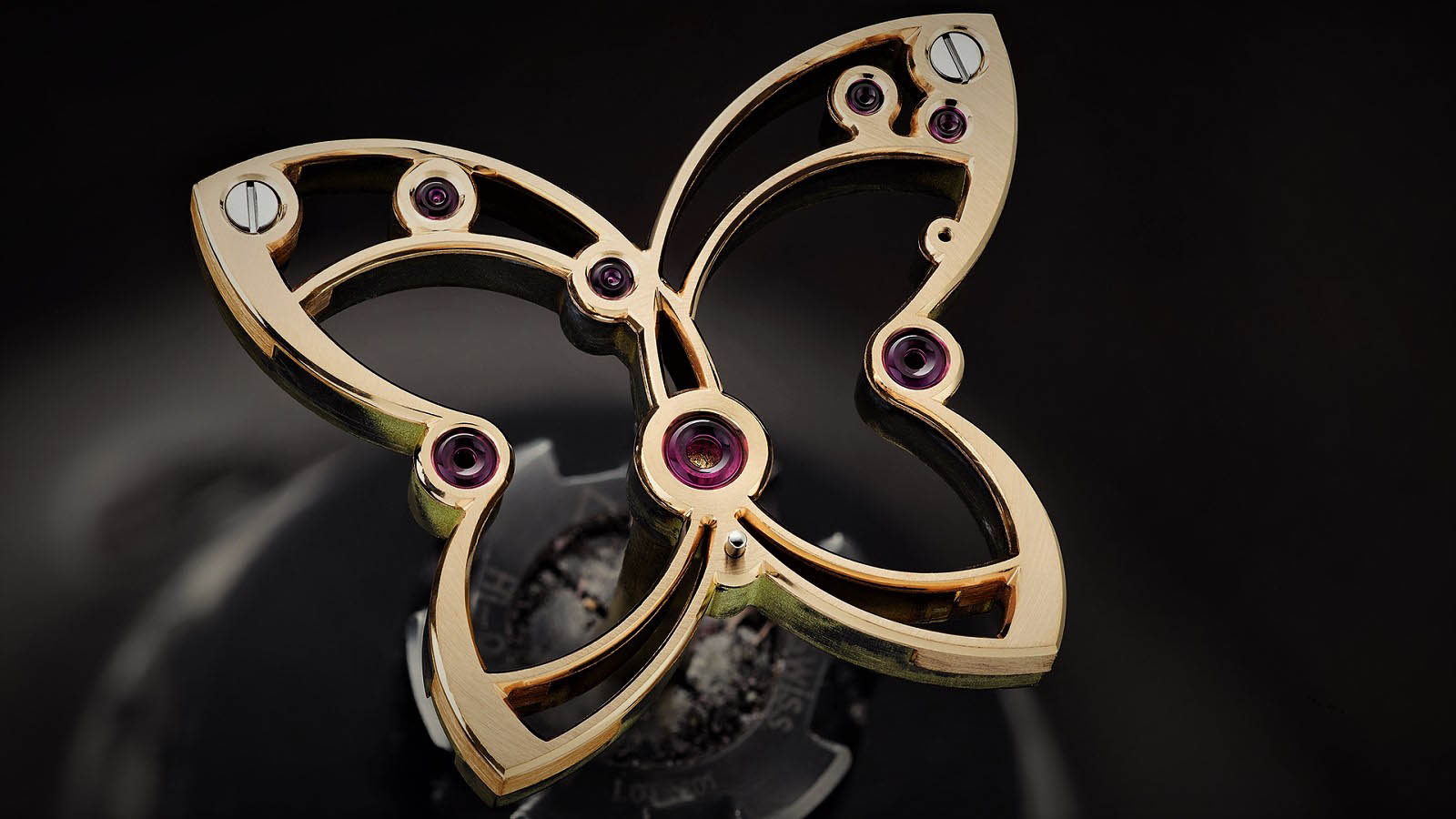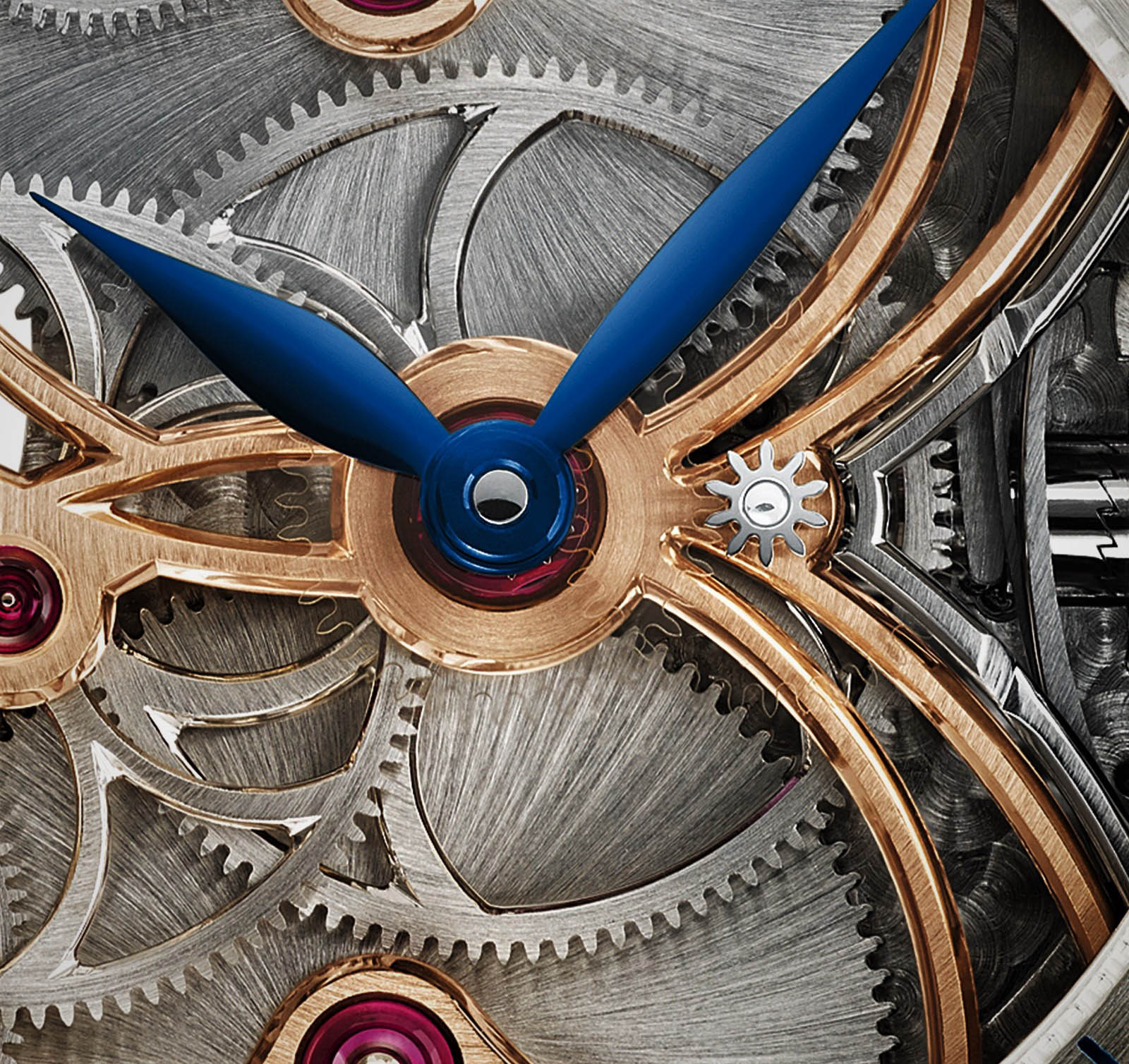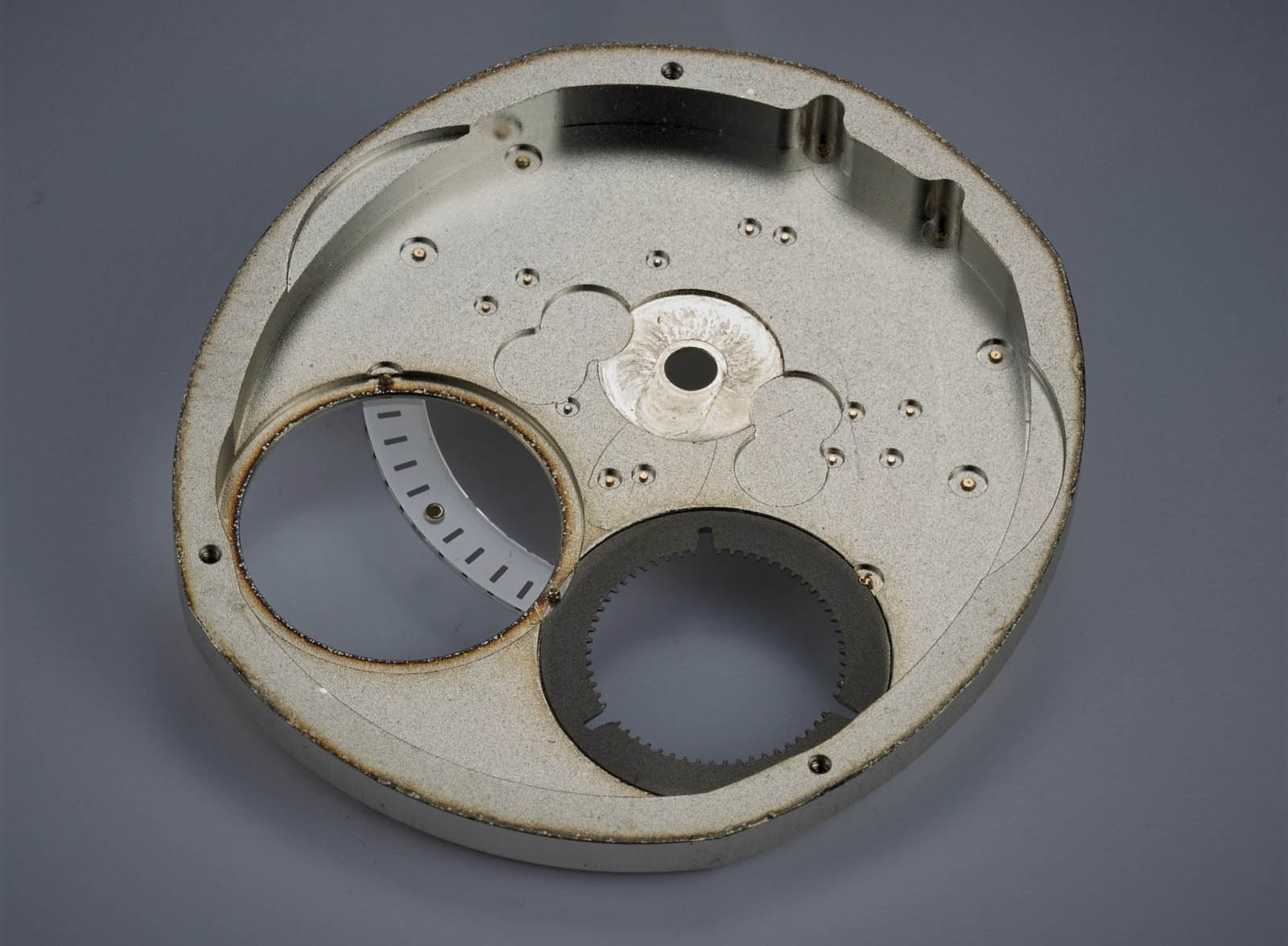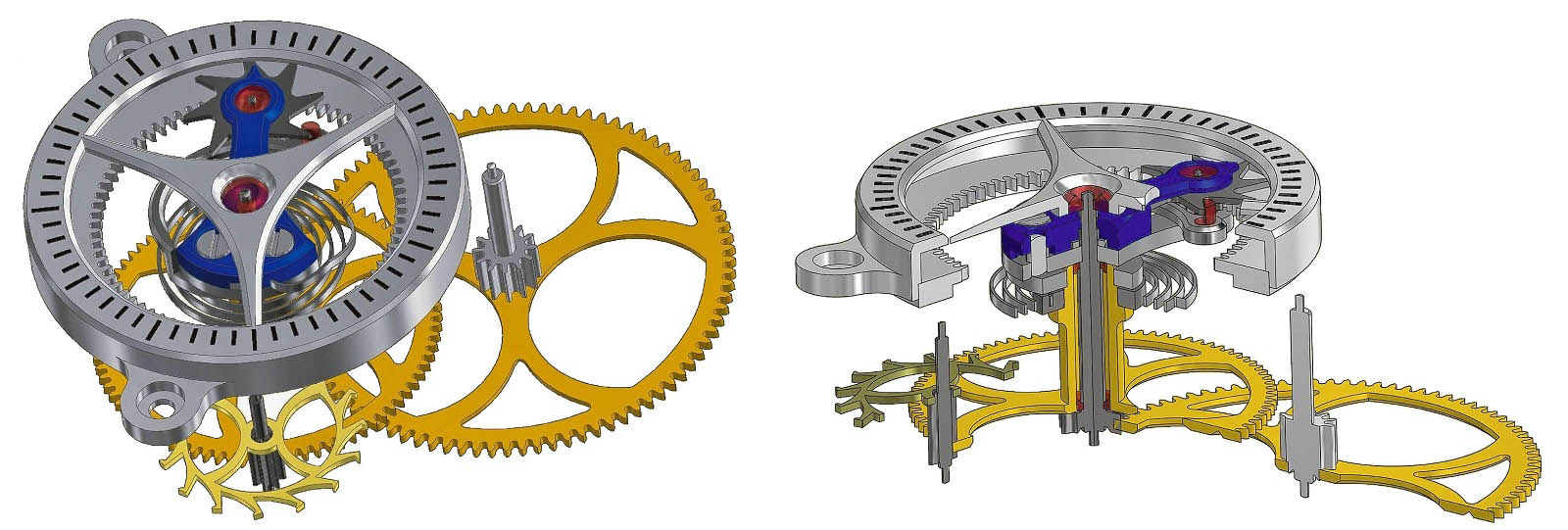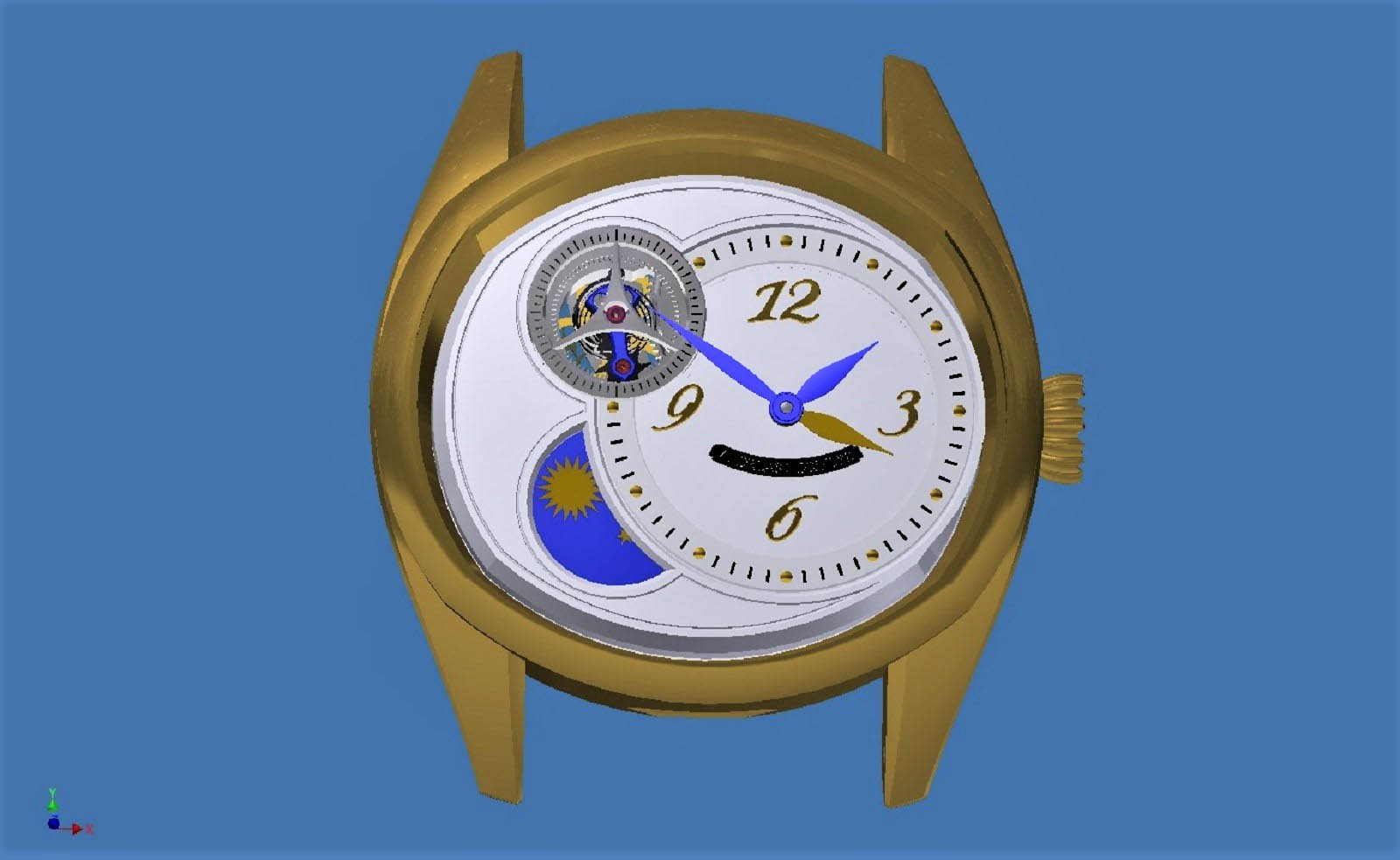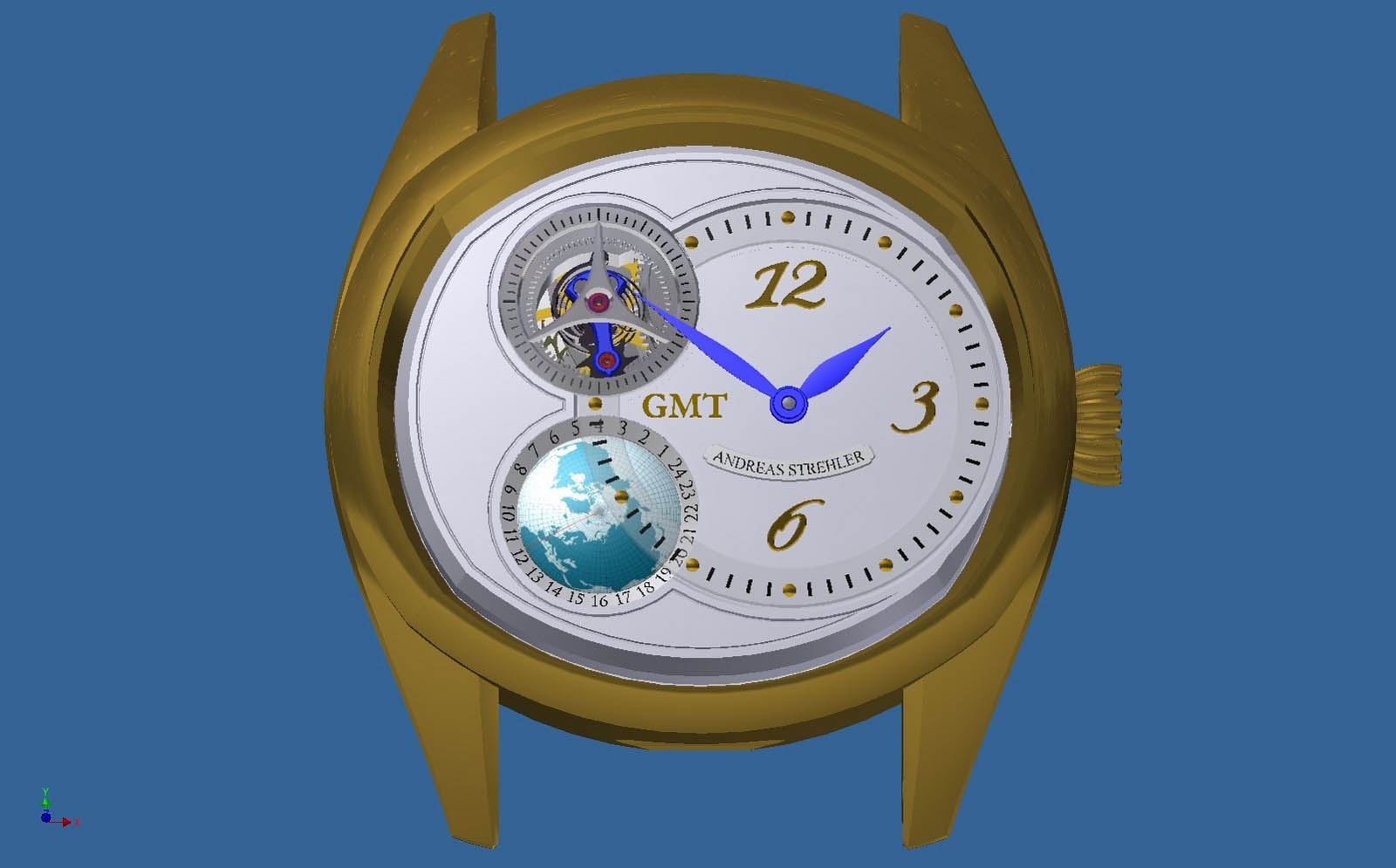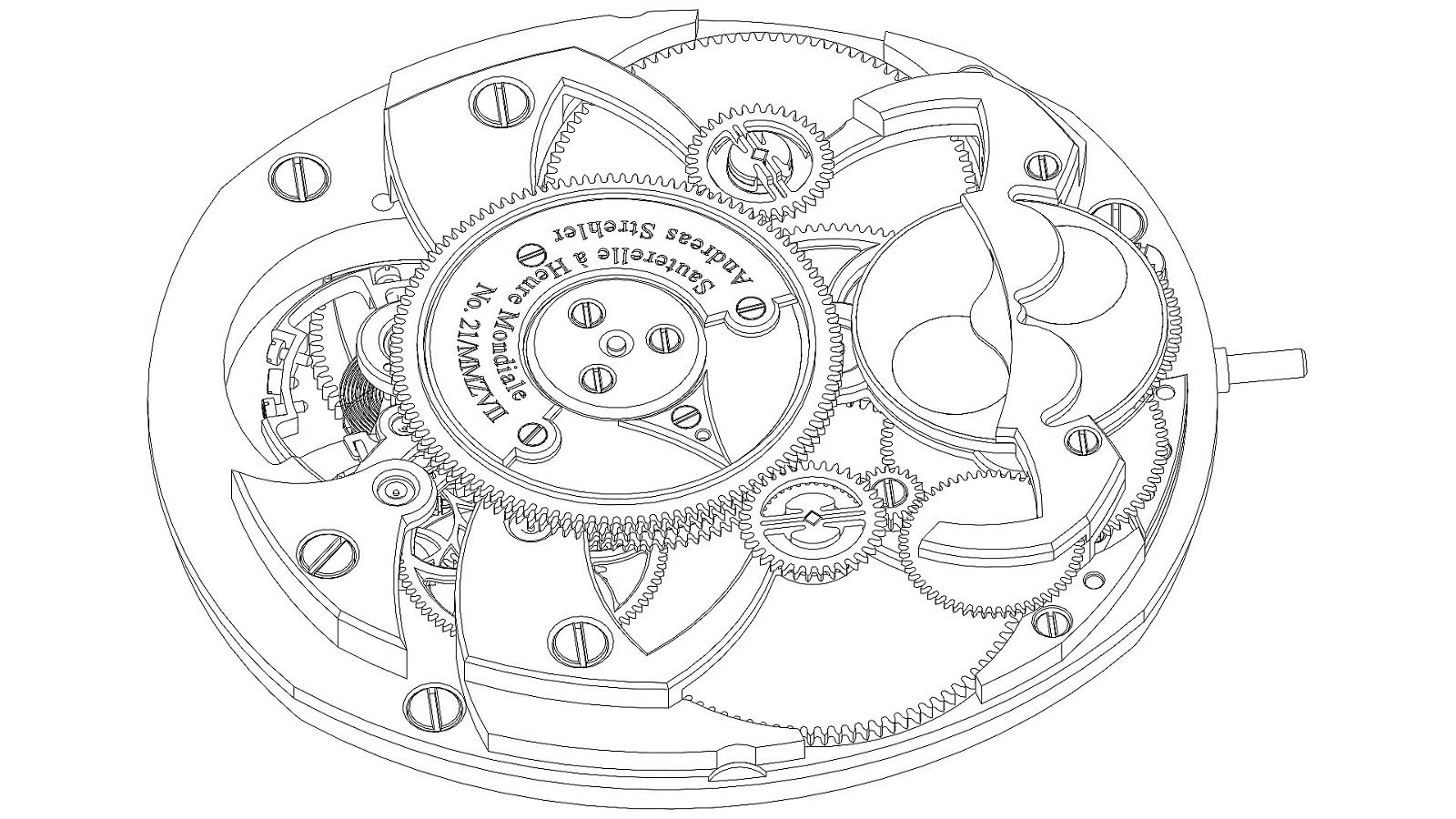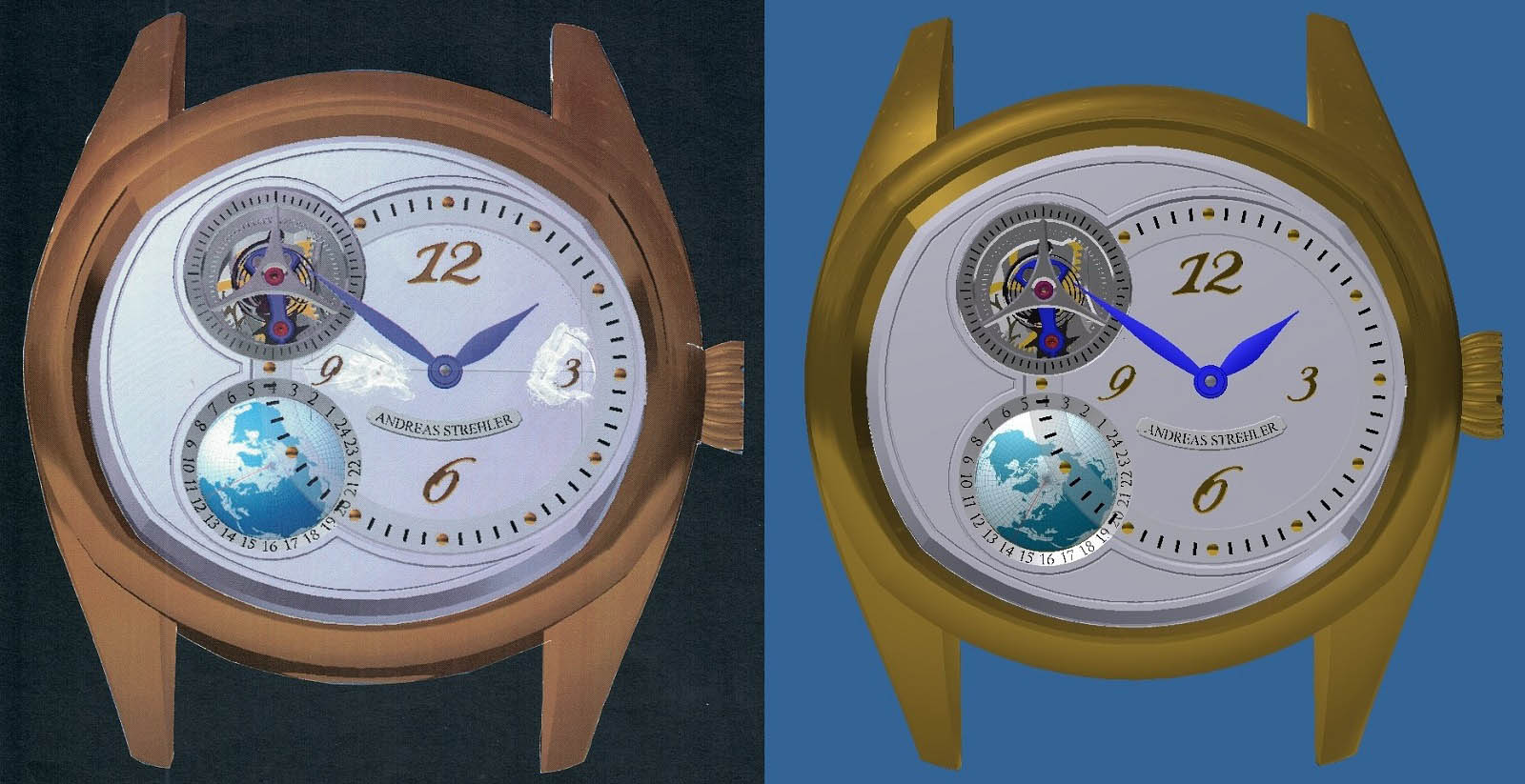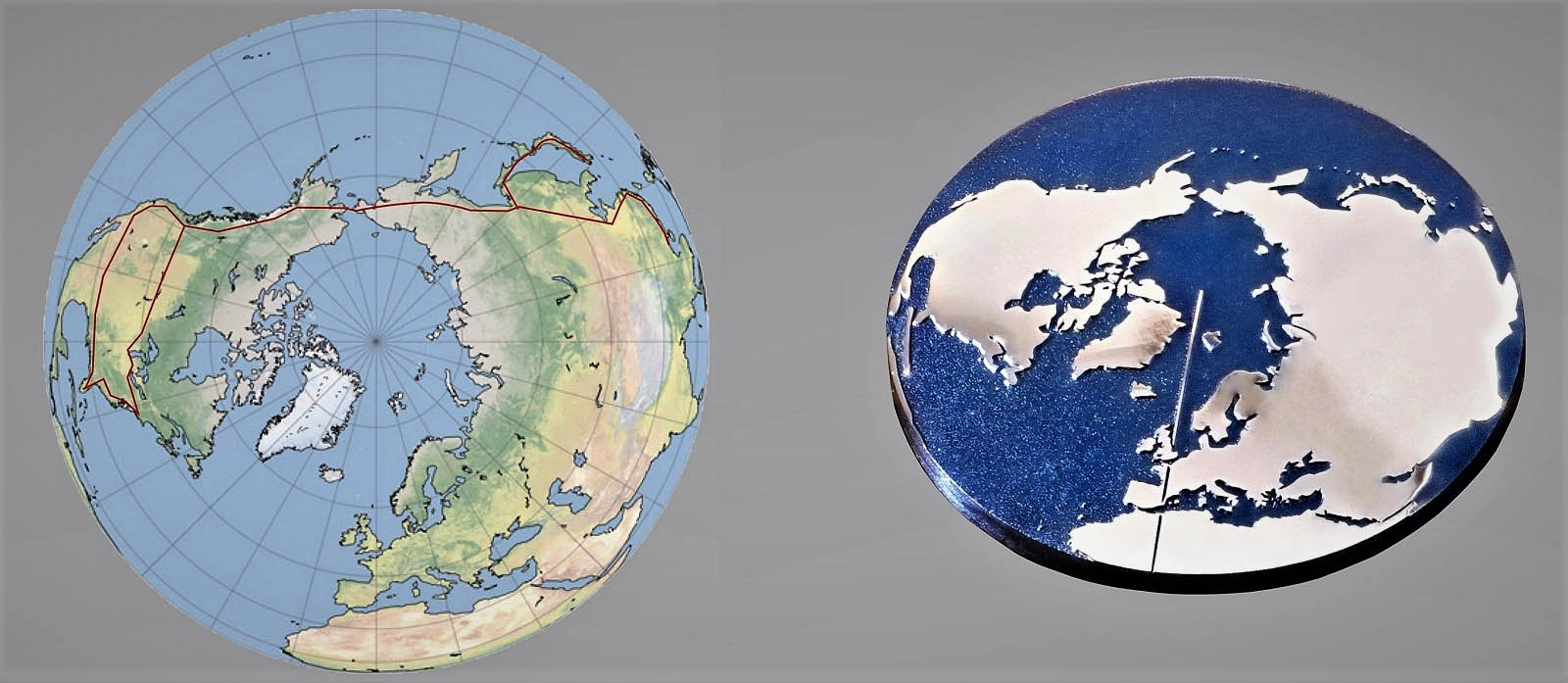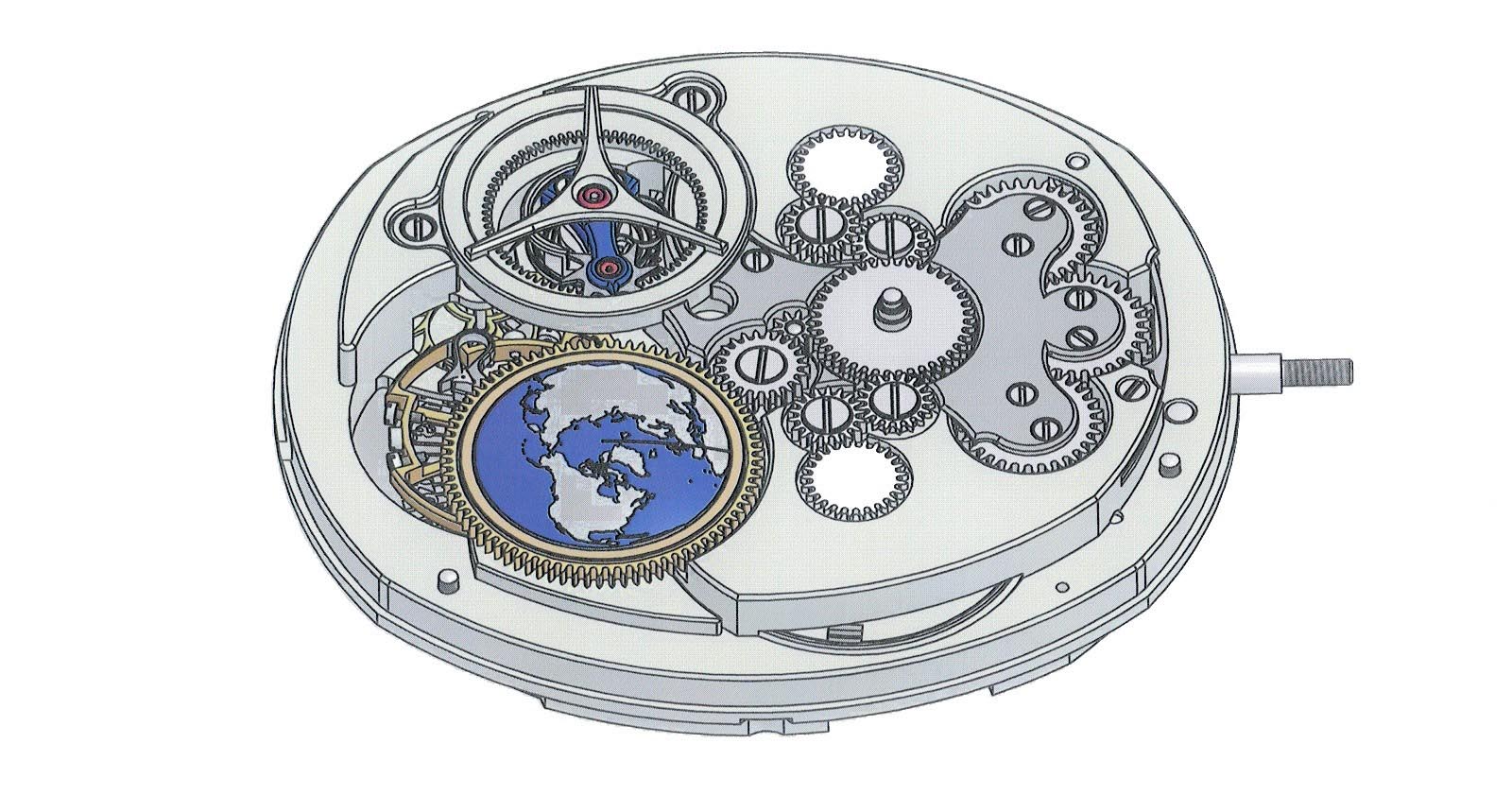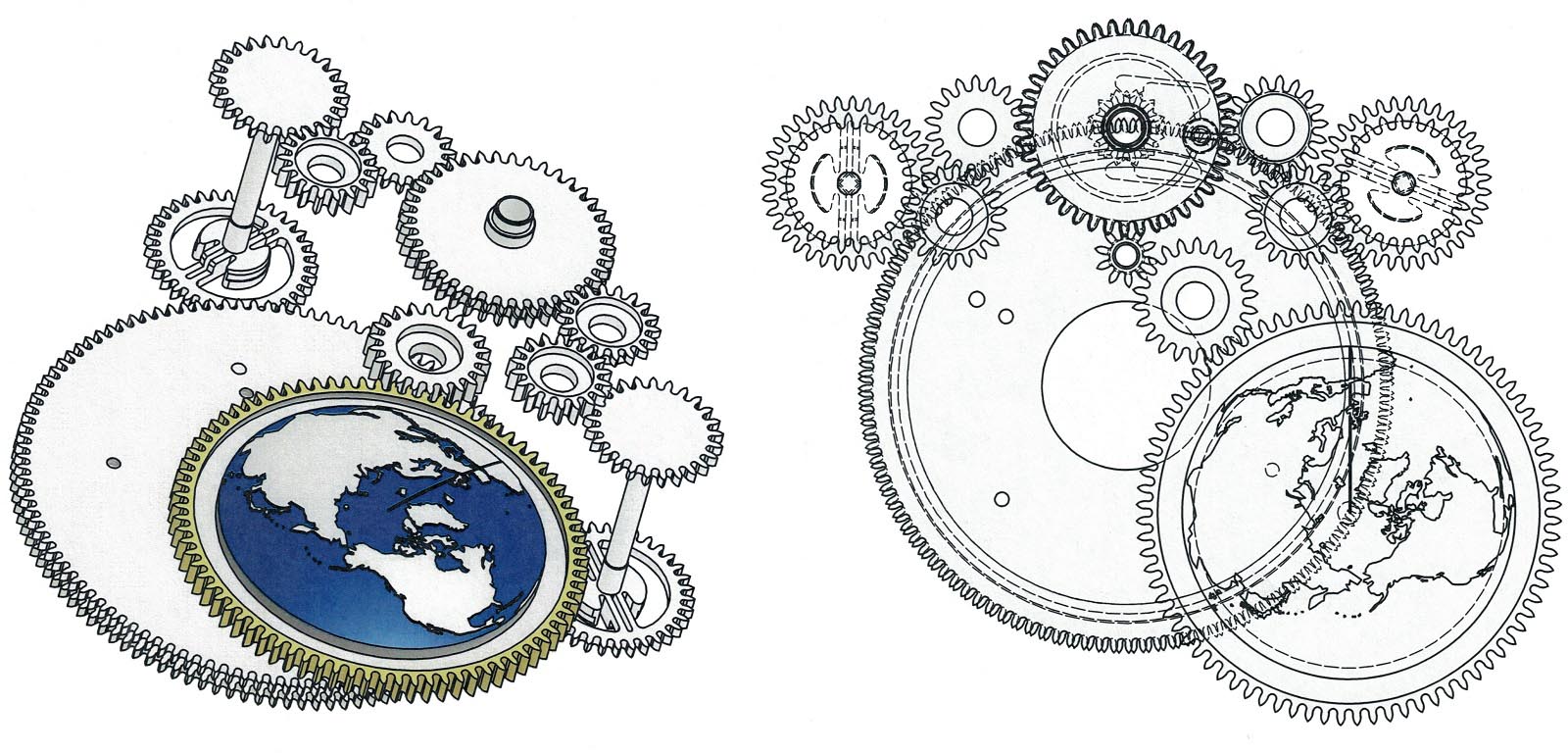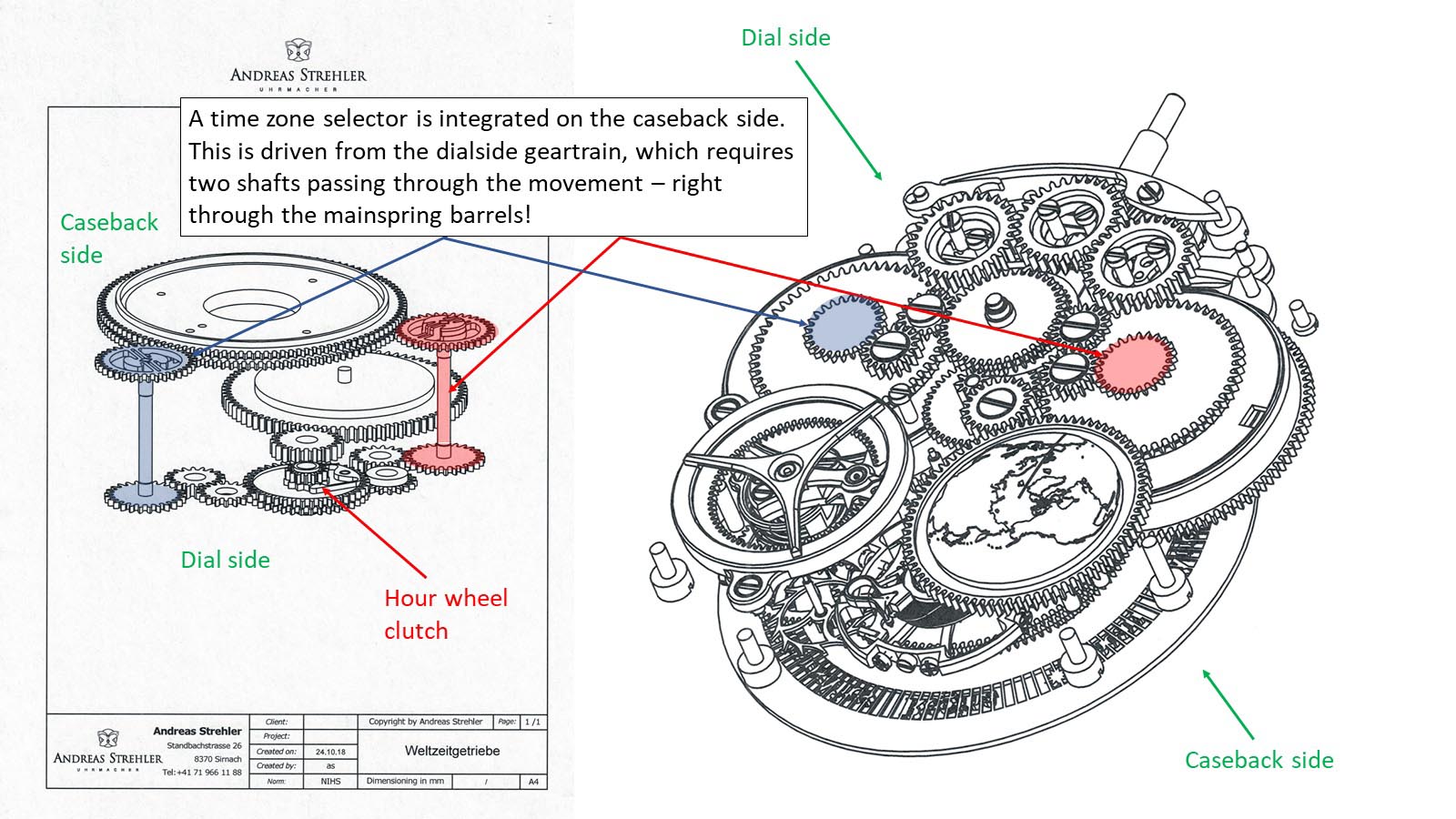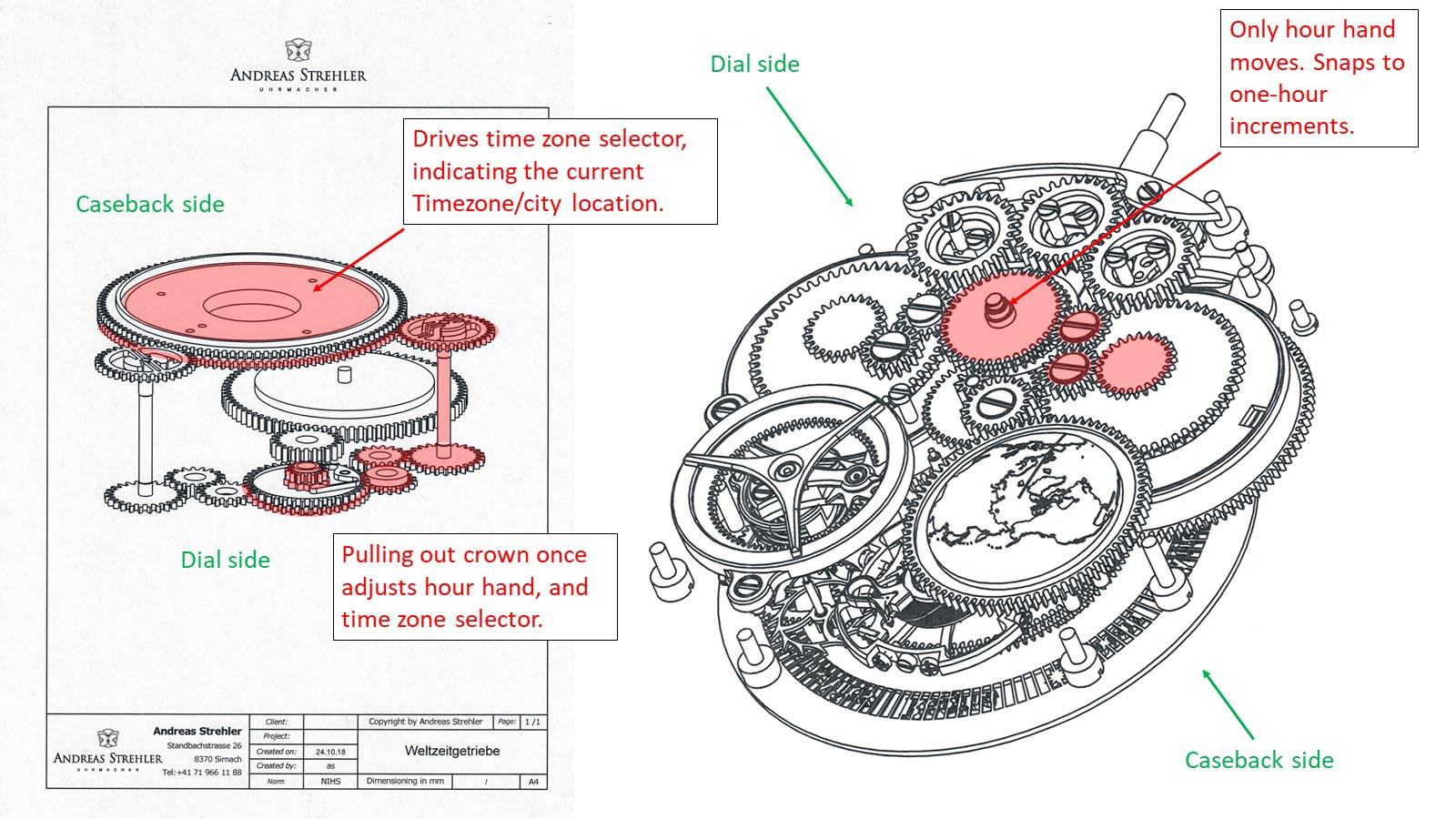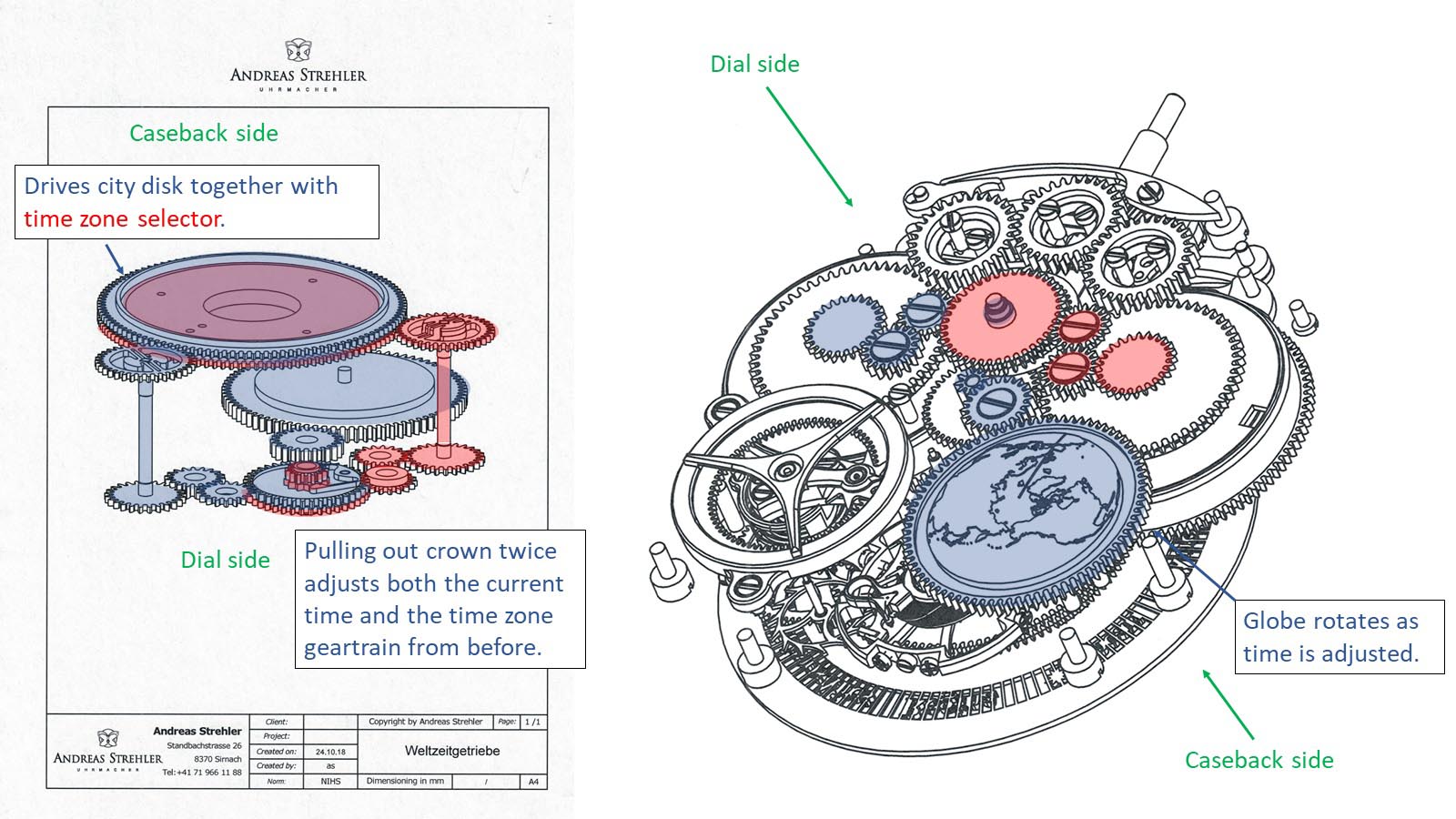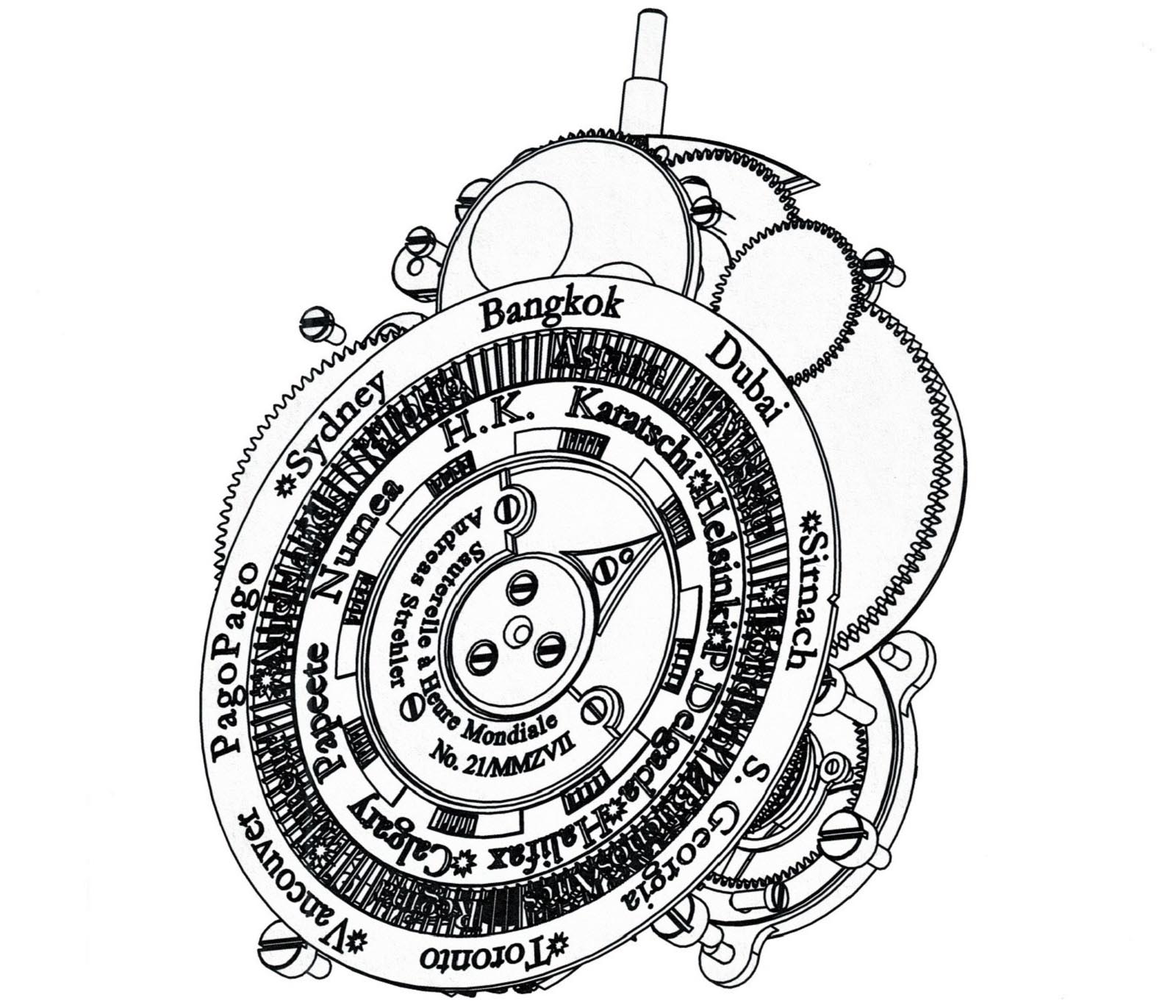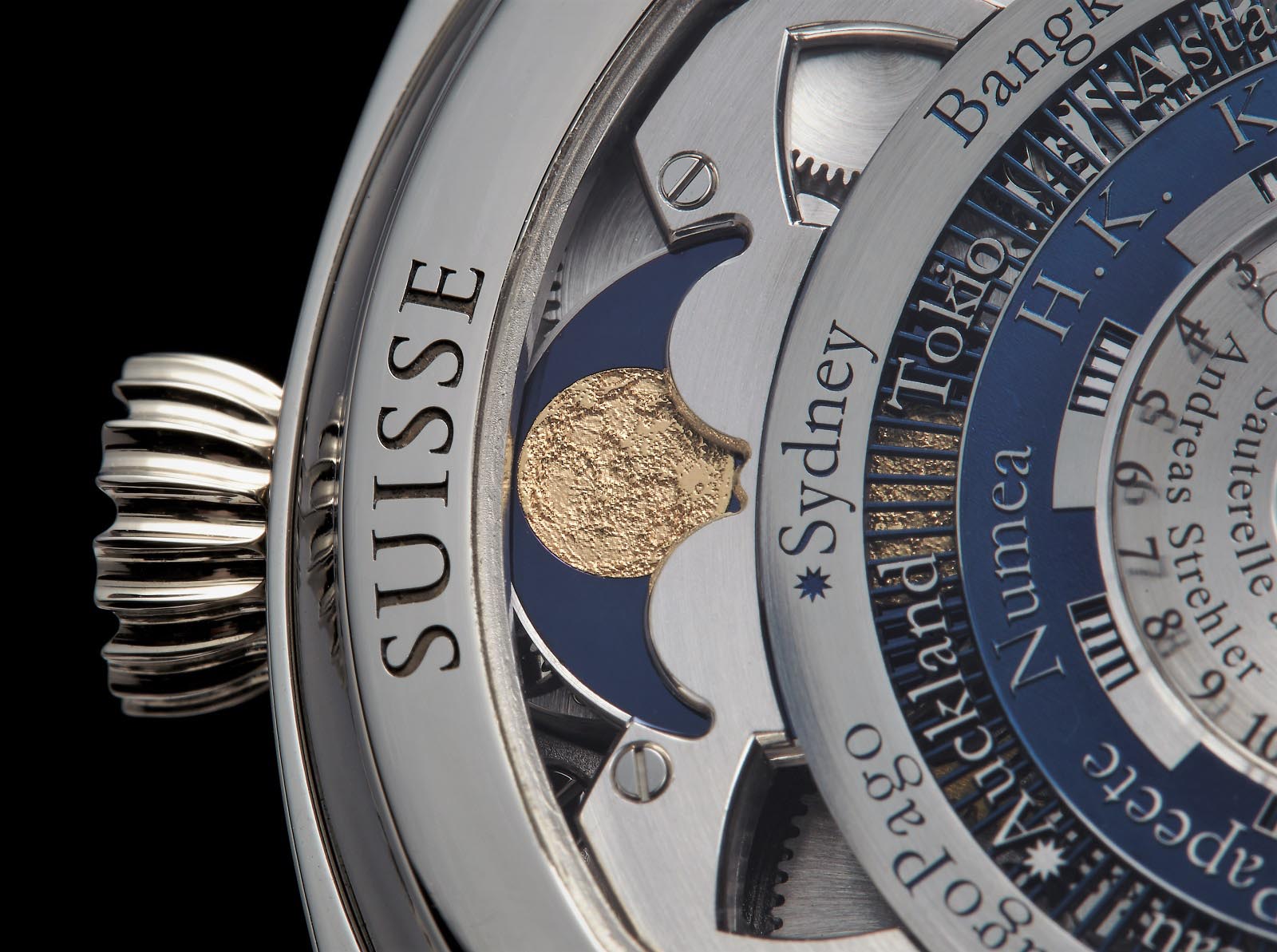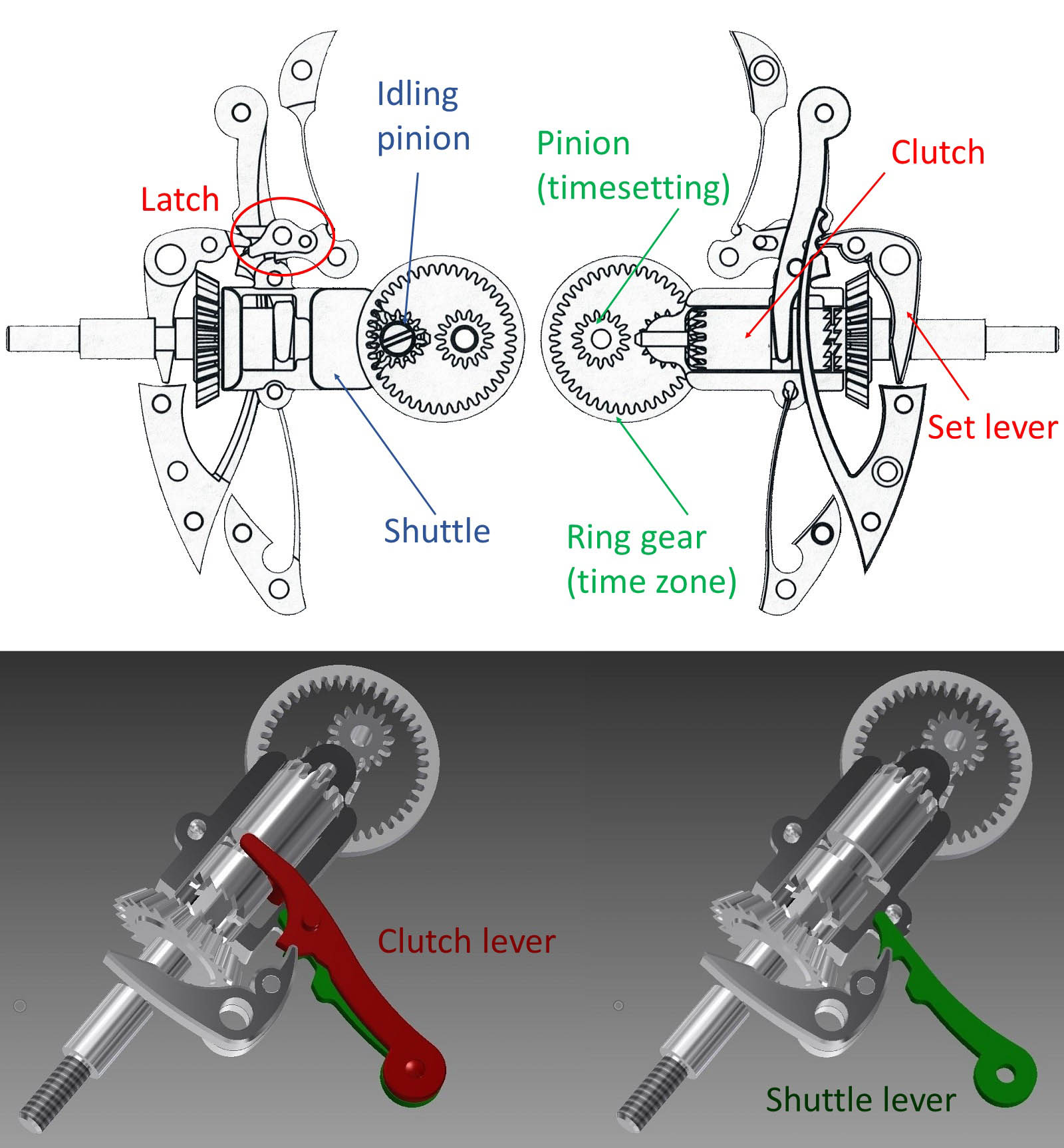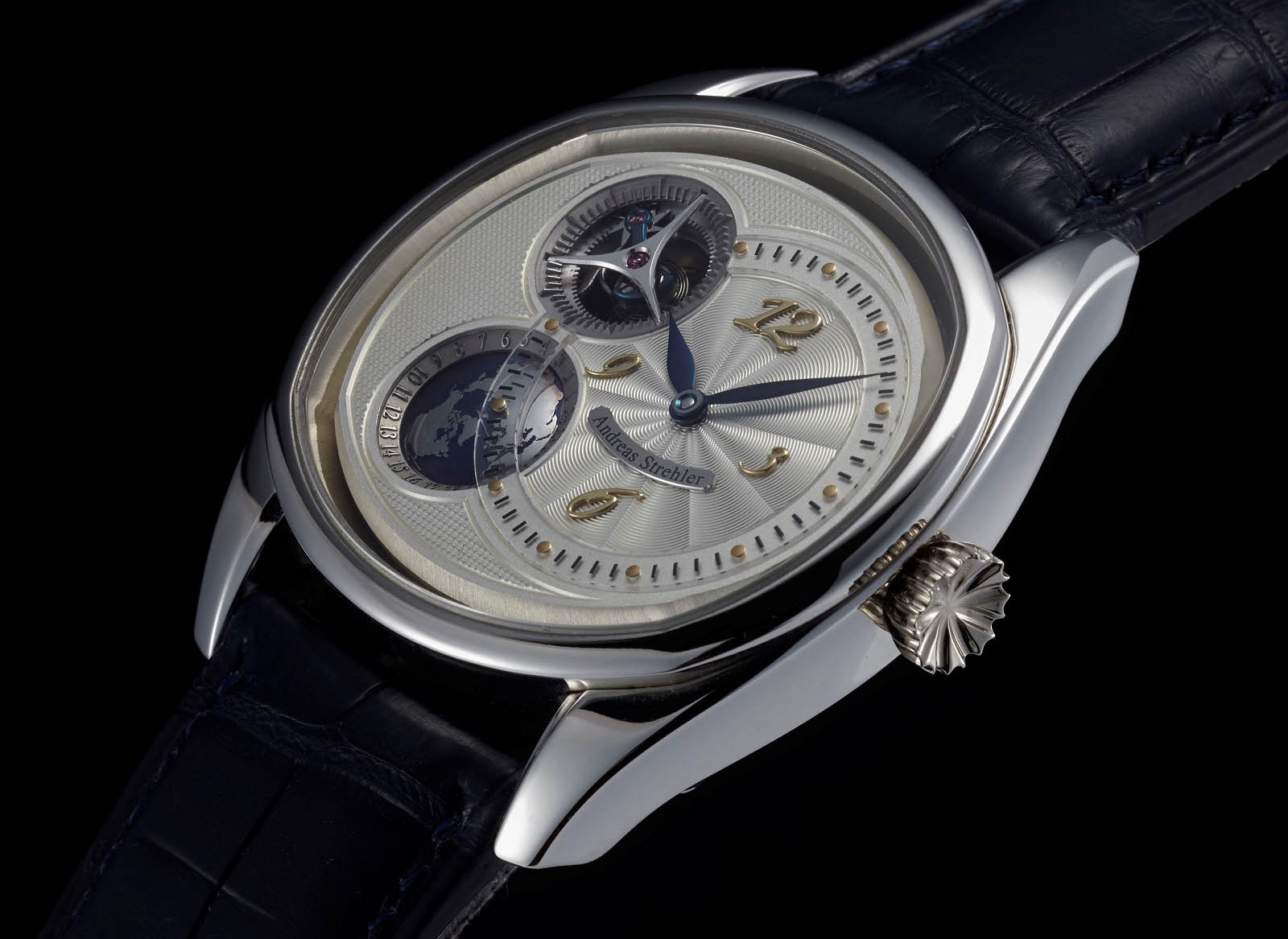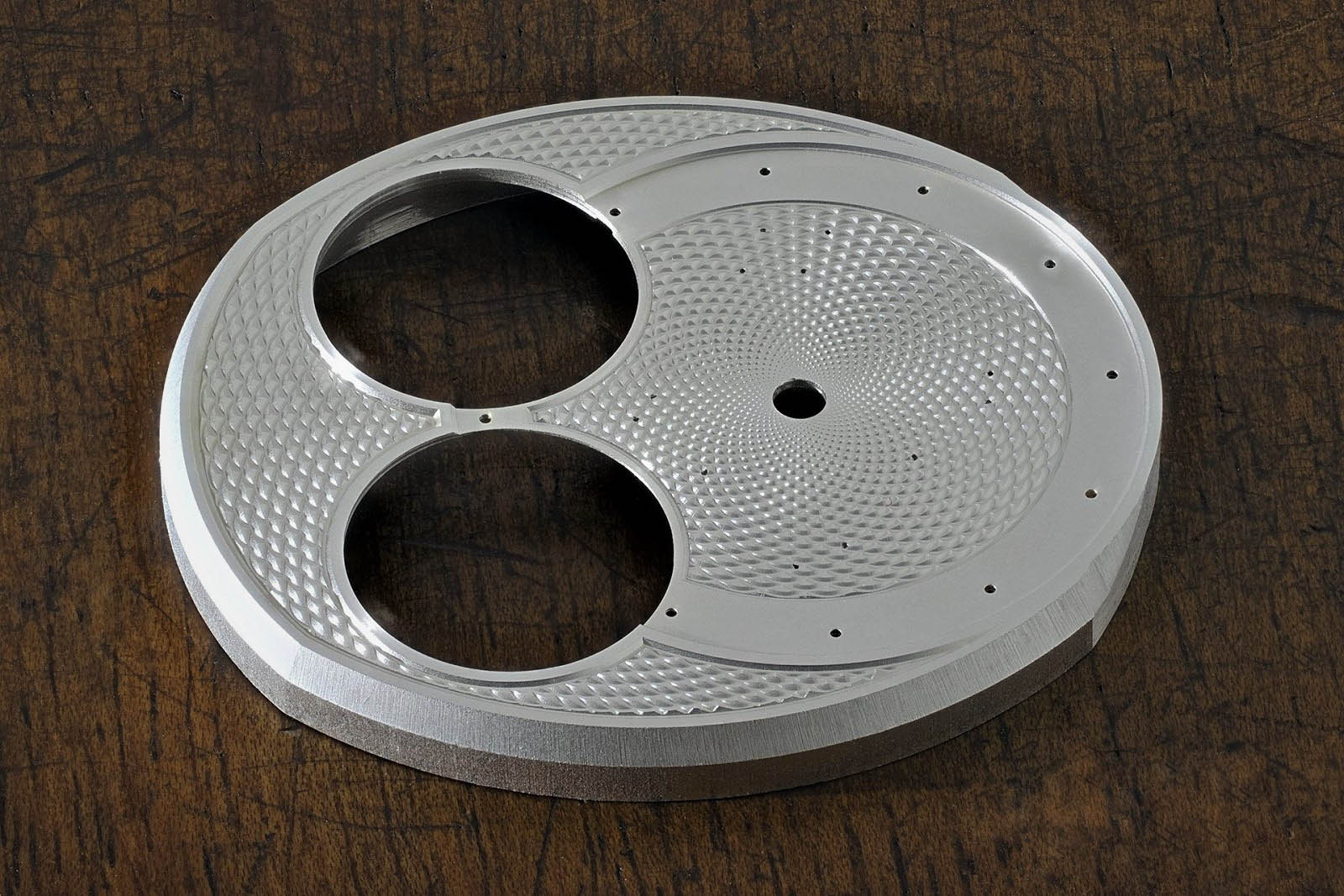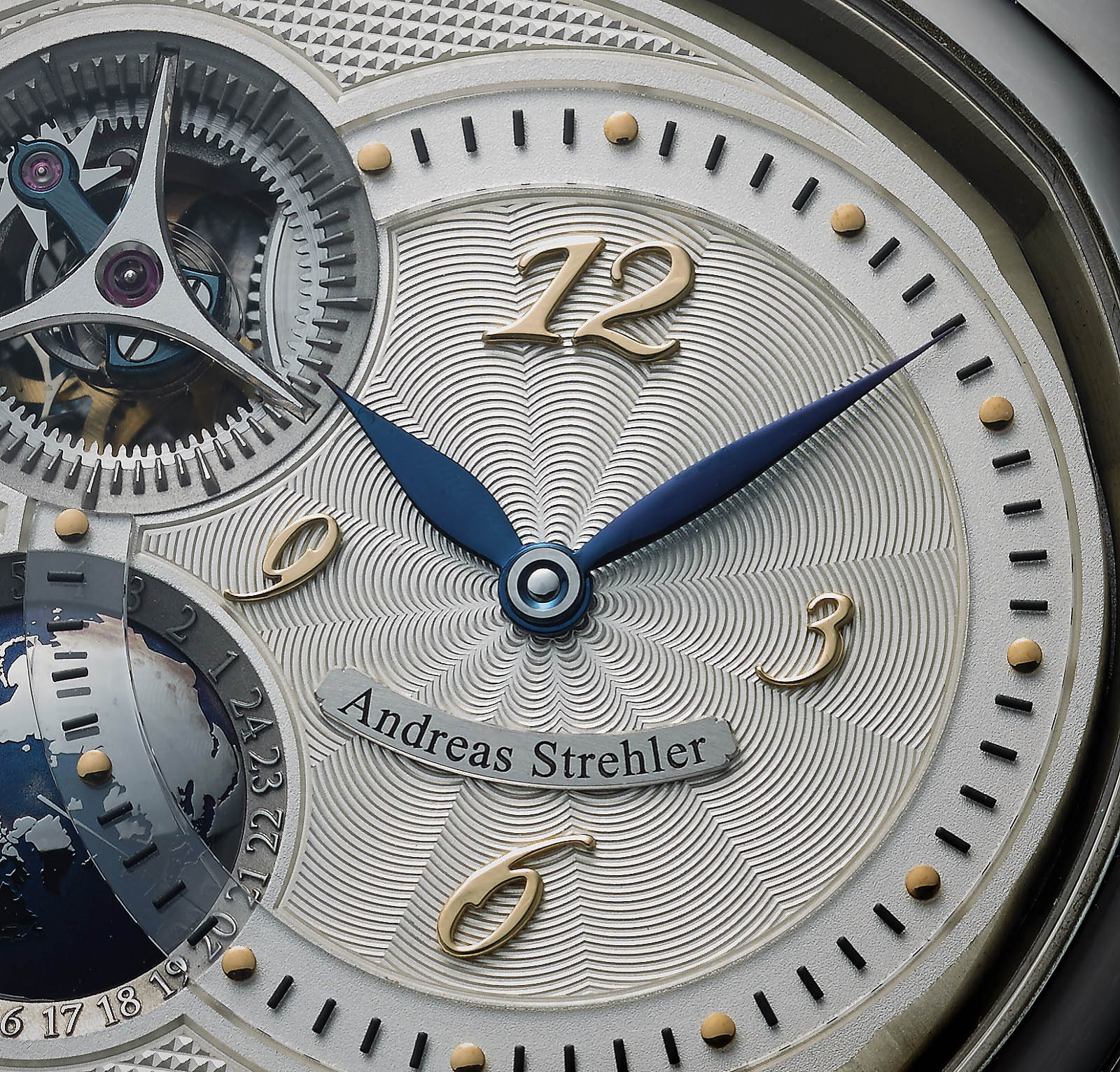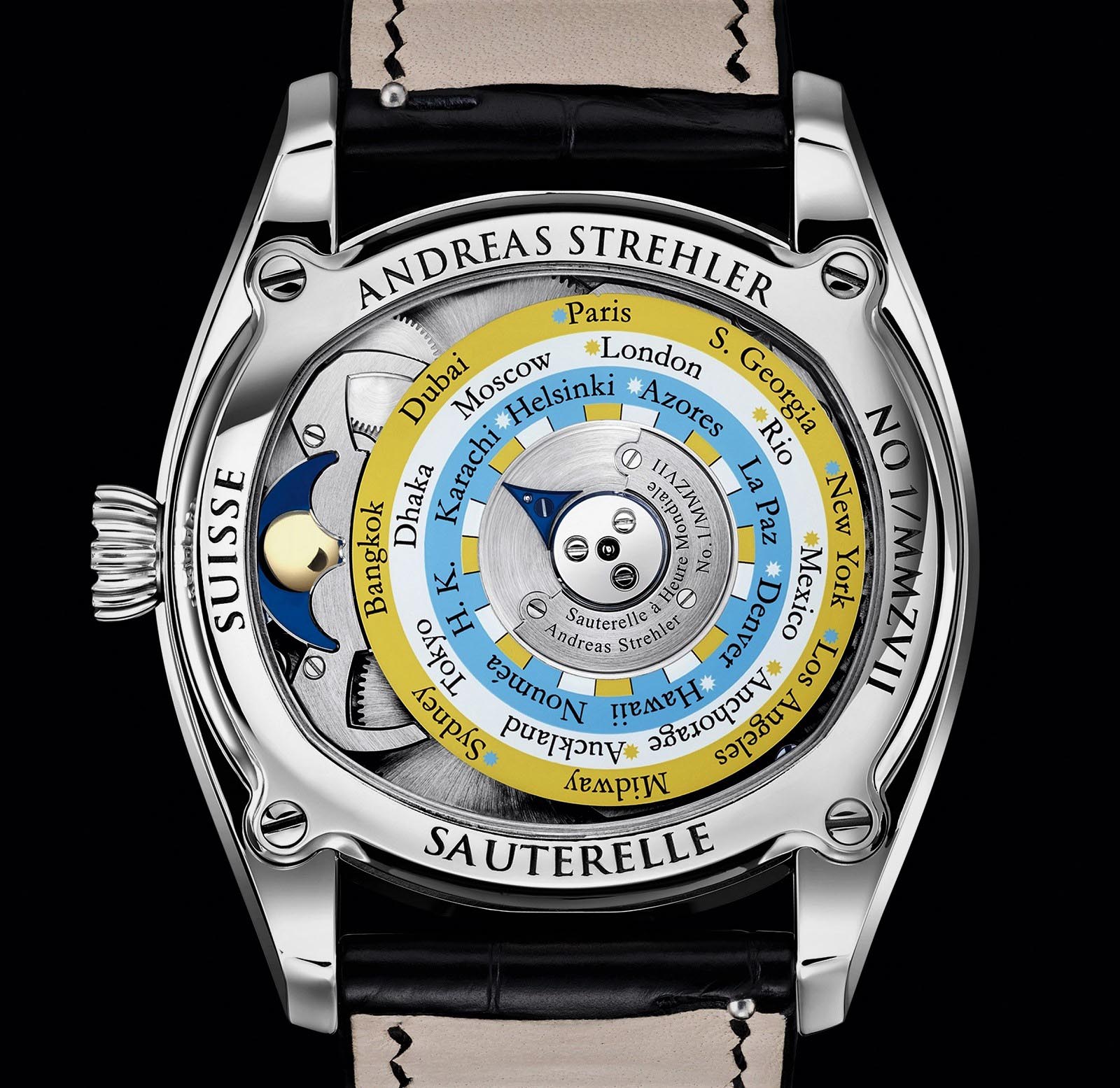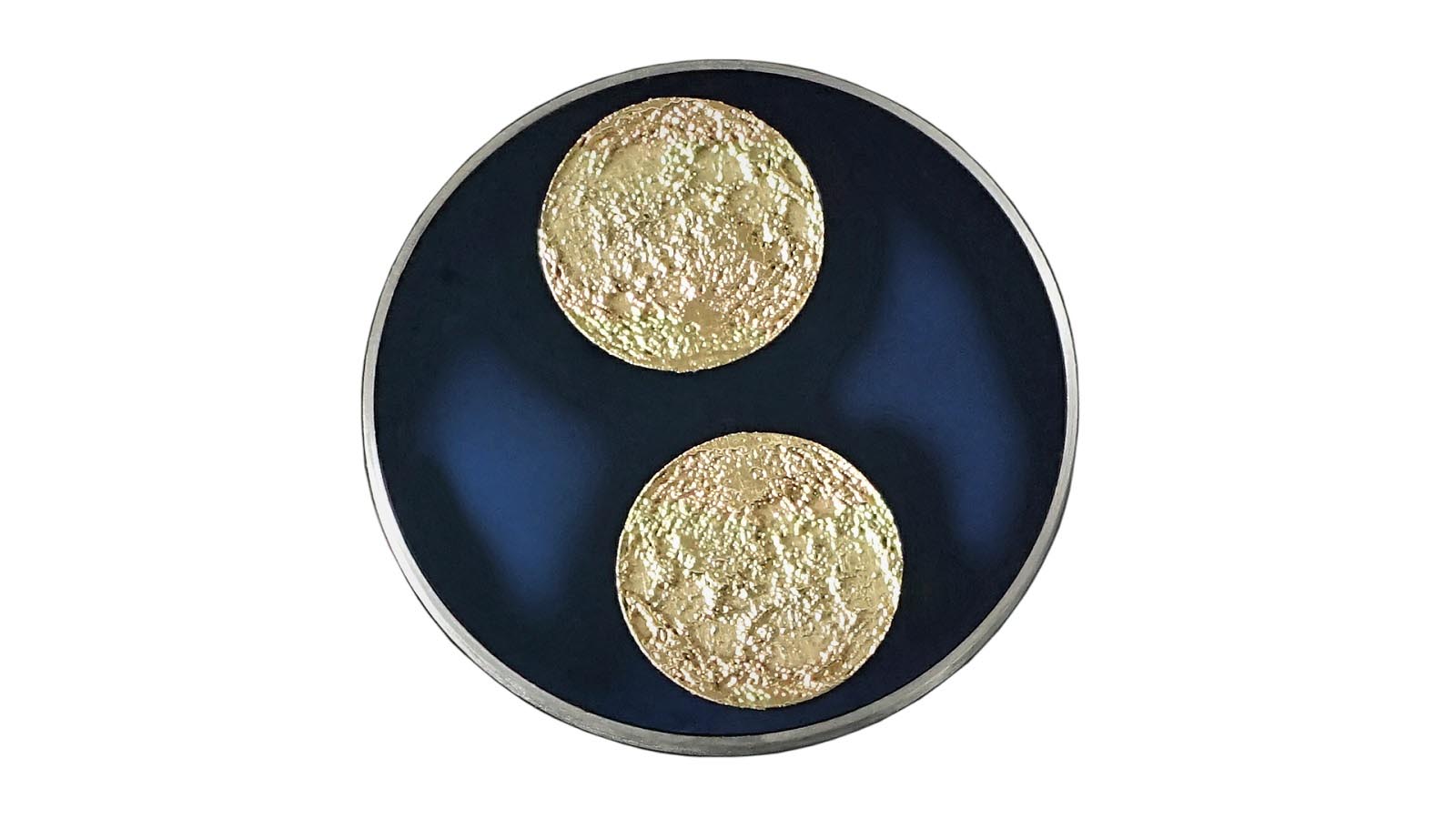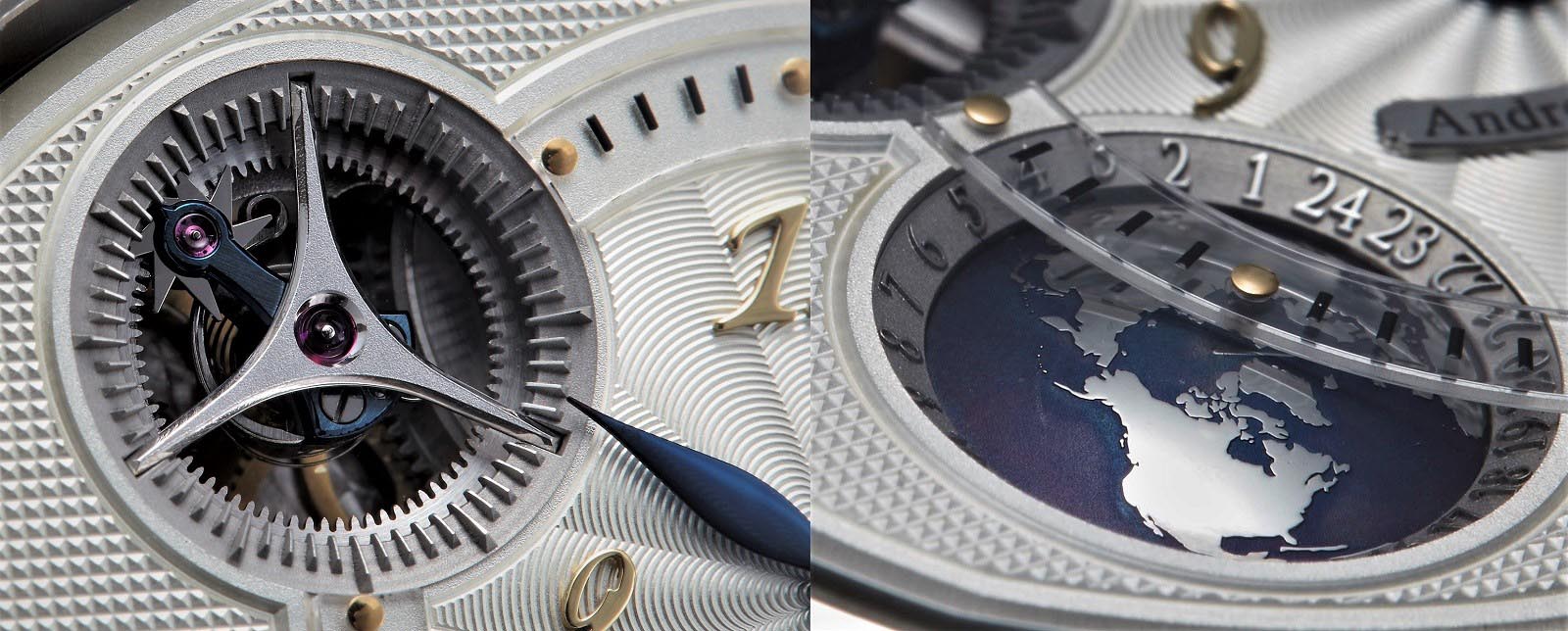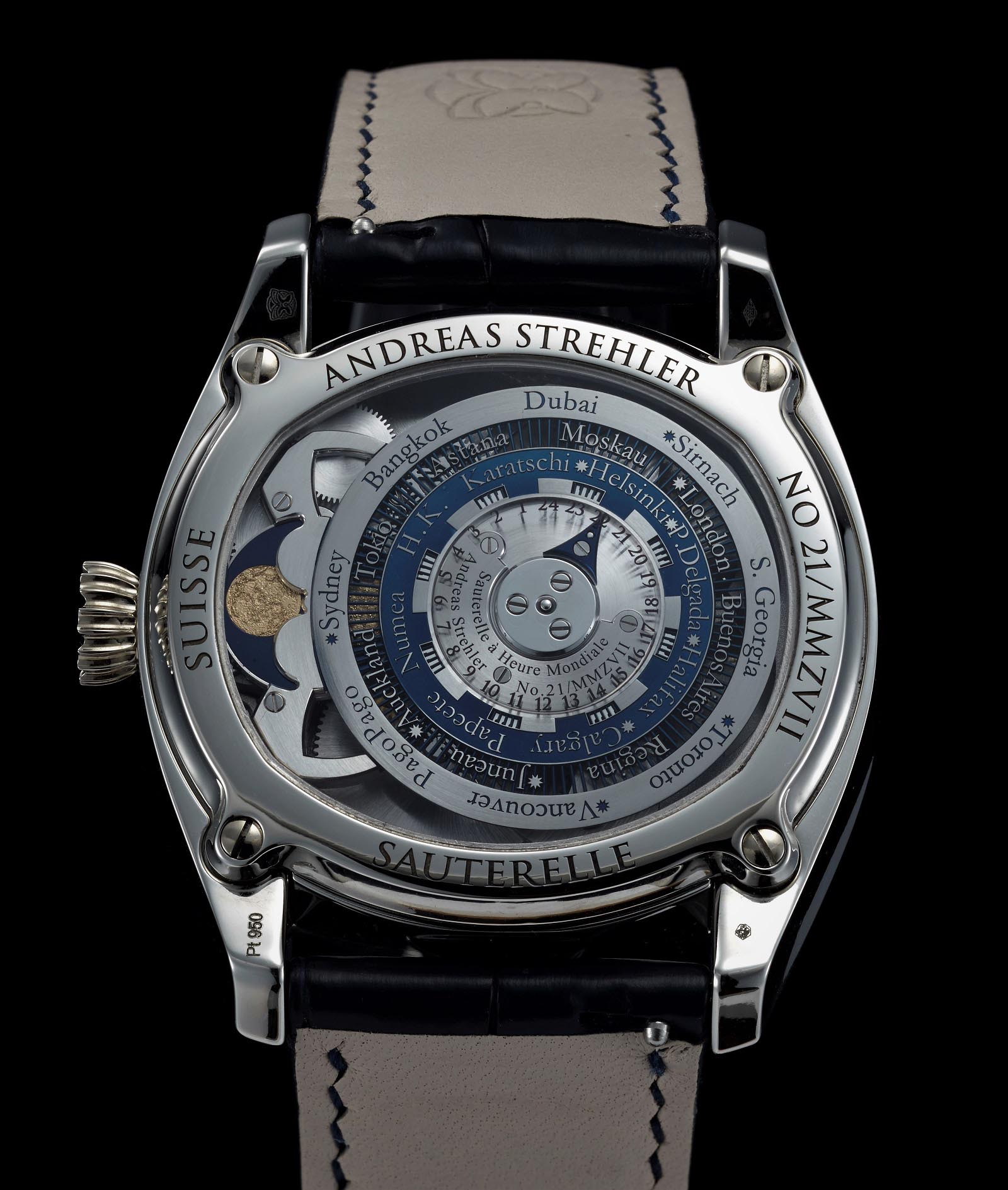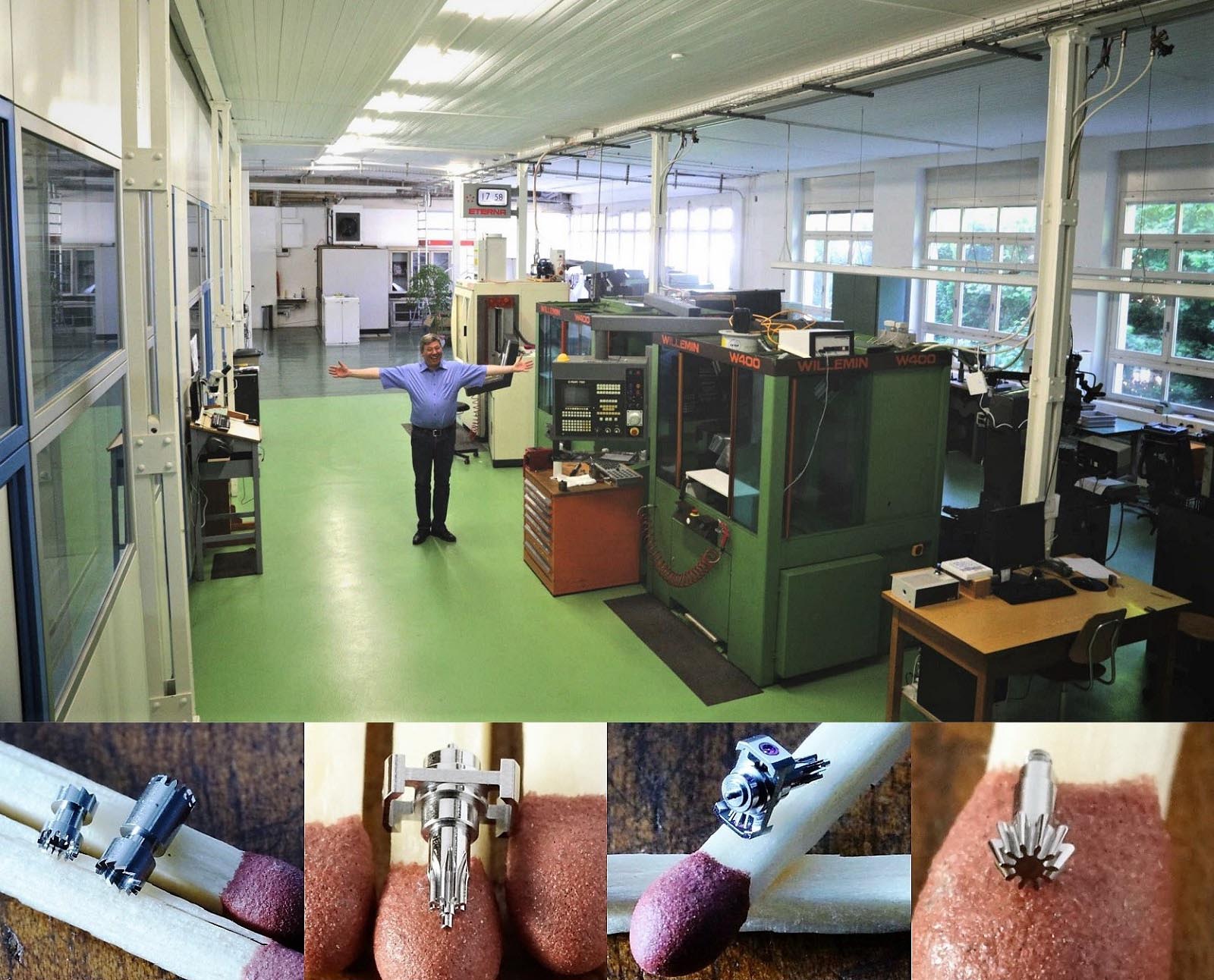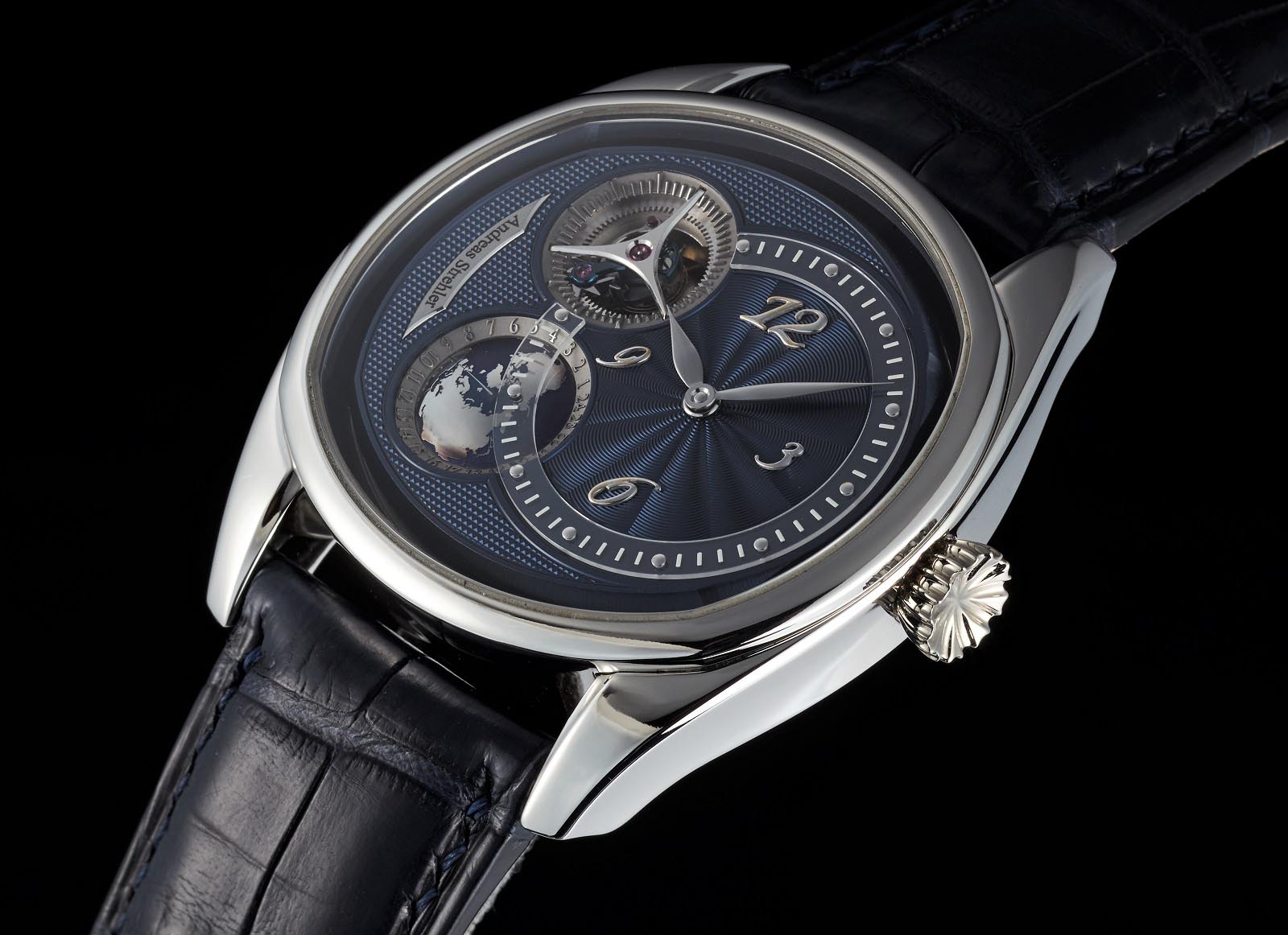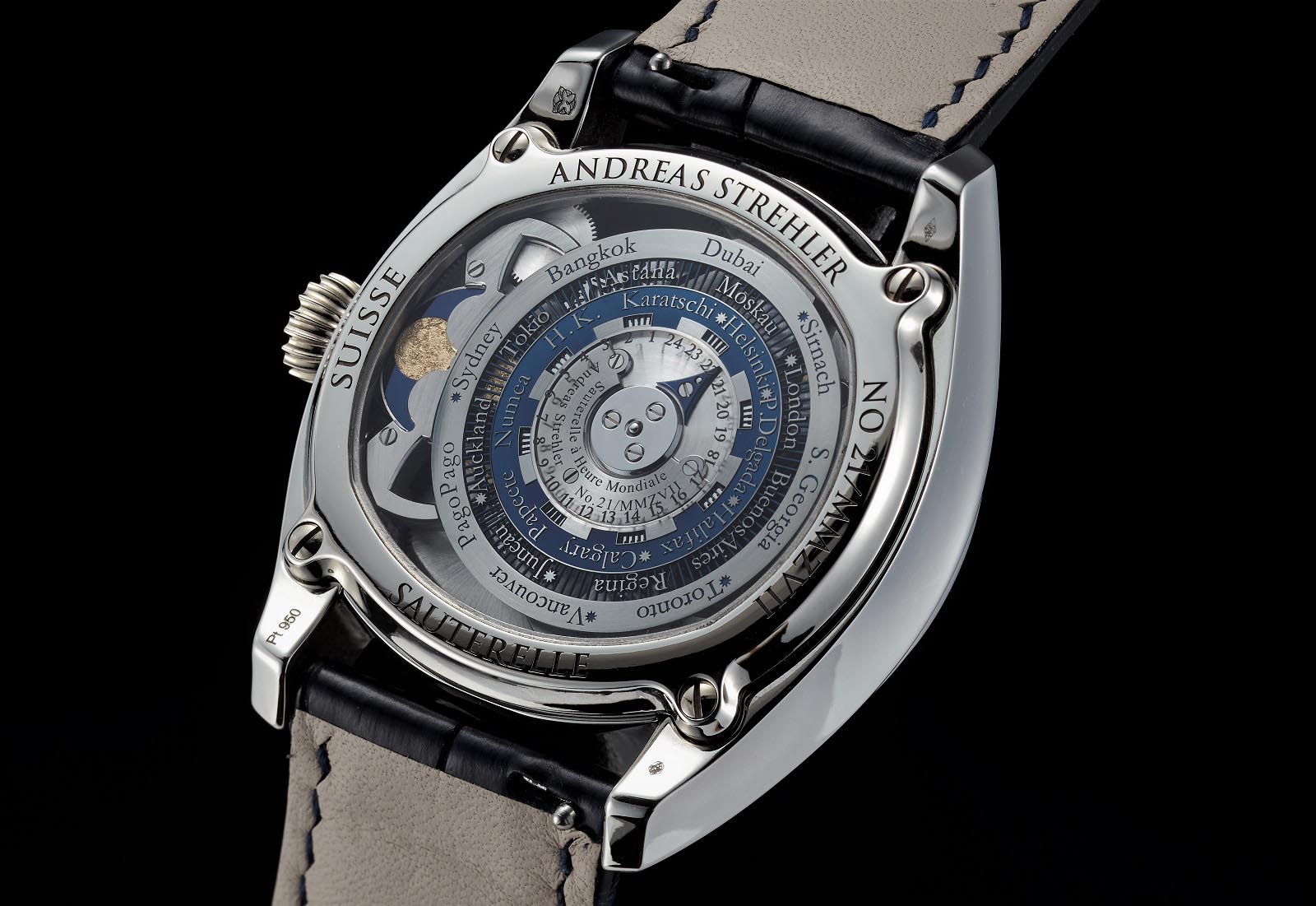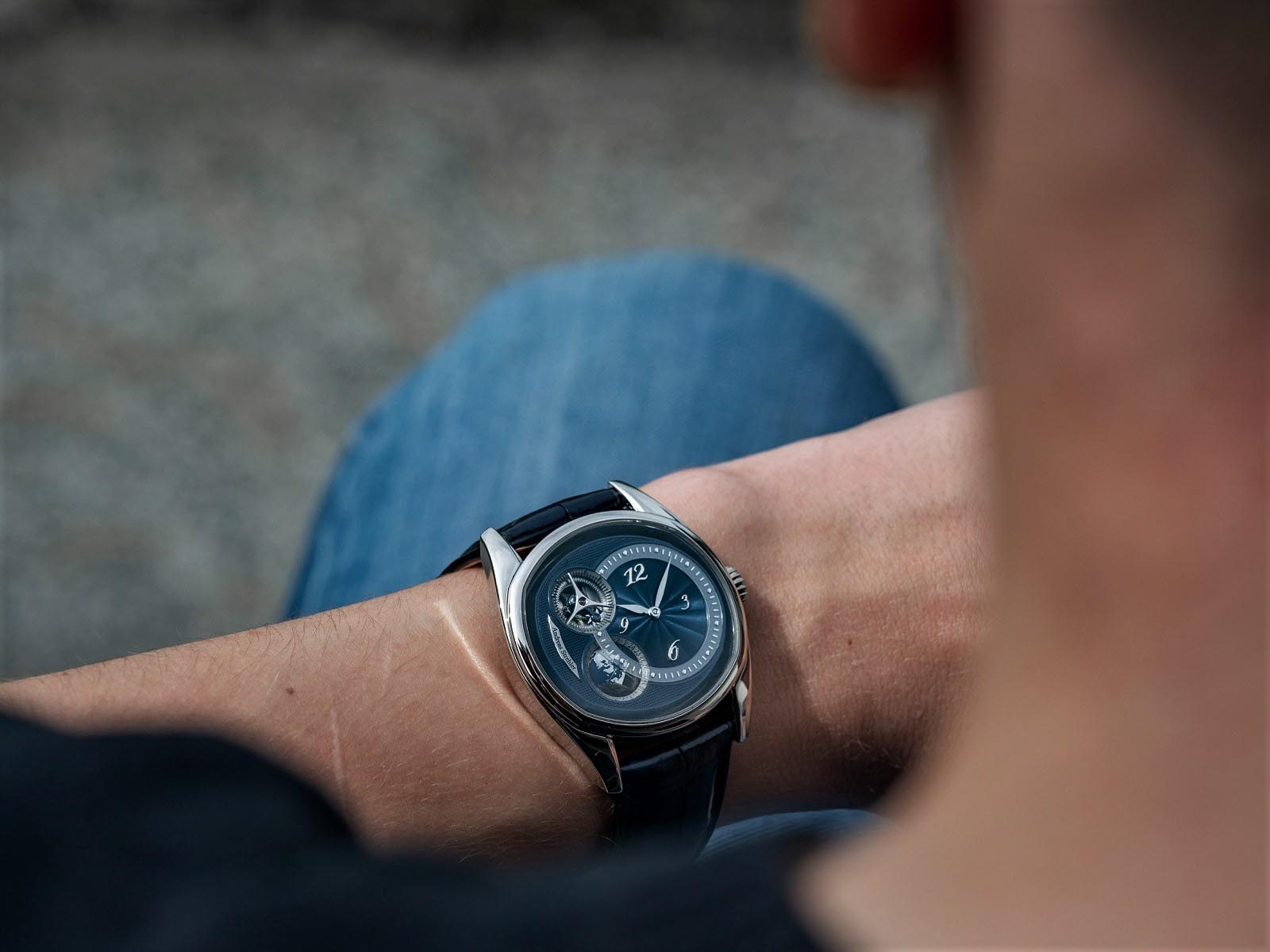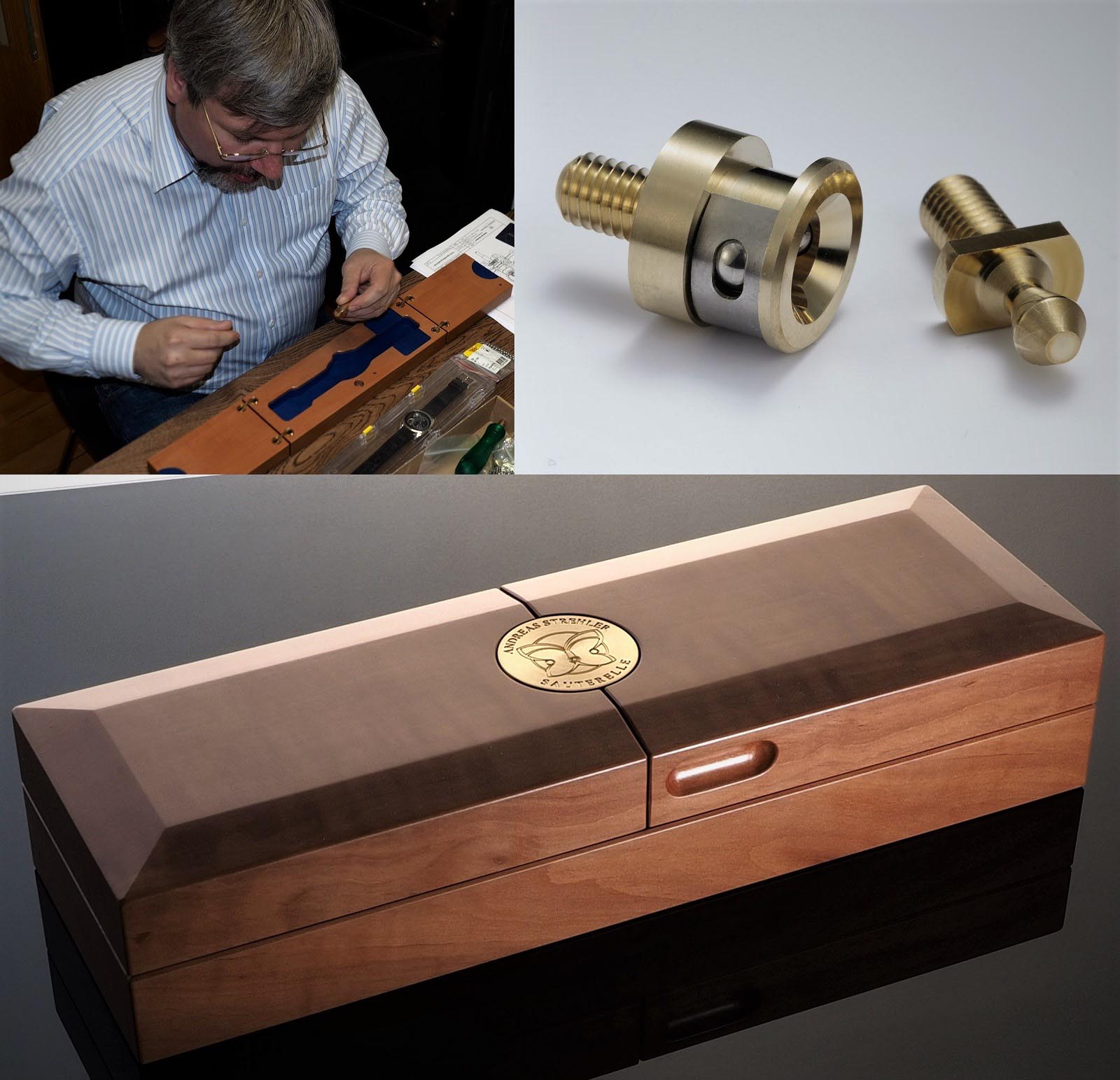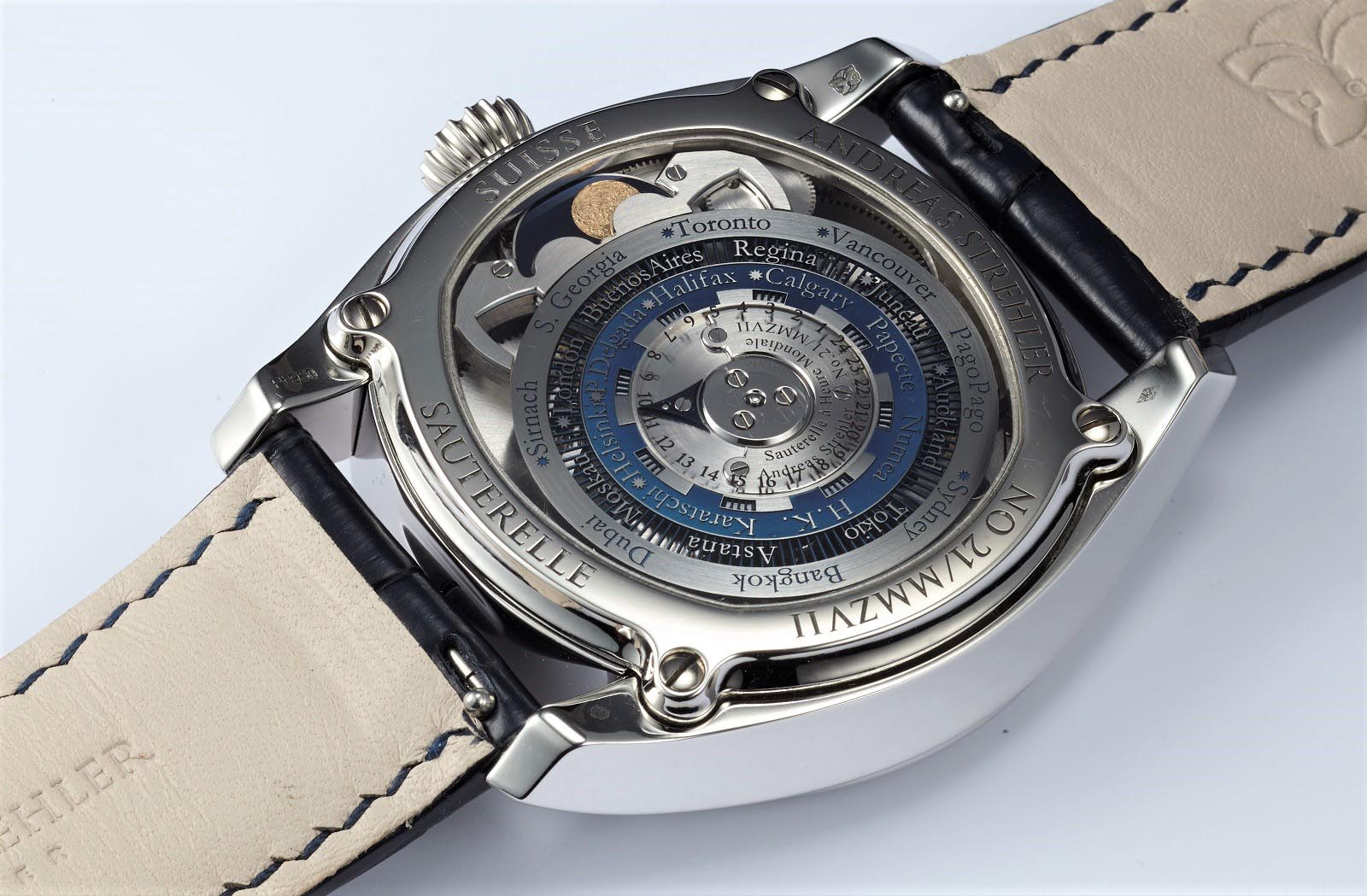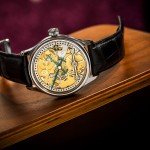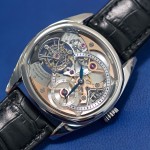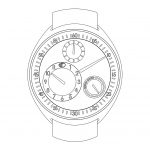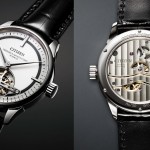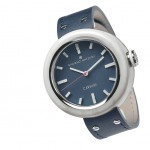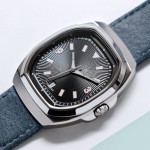In-Depth: Commissioning a Custom Andreas Strehler Wristwatch
A unique time zone creation.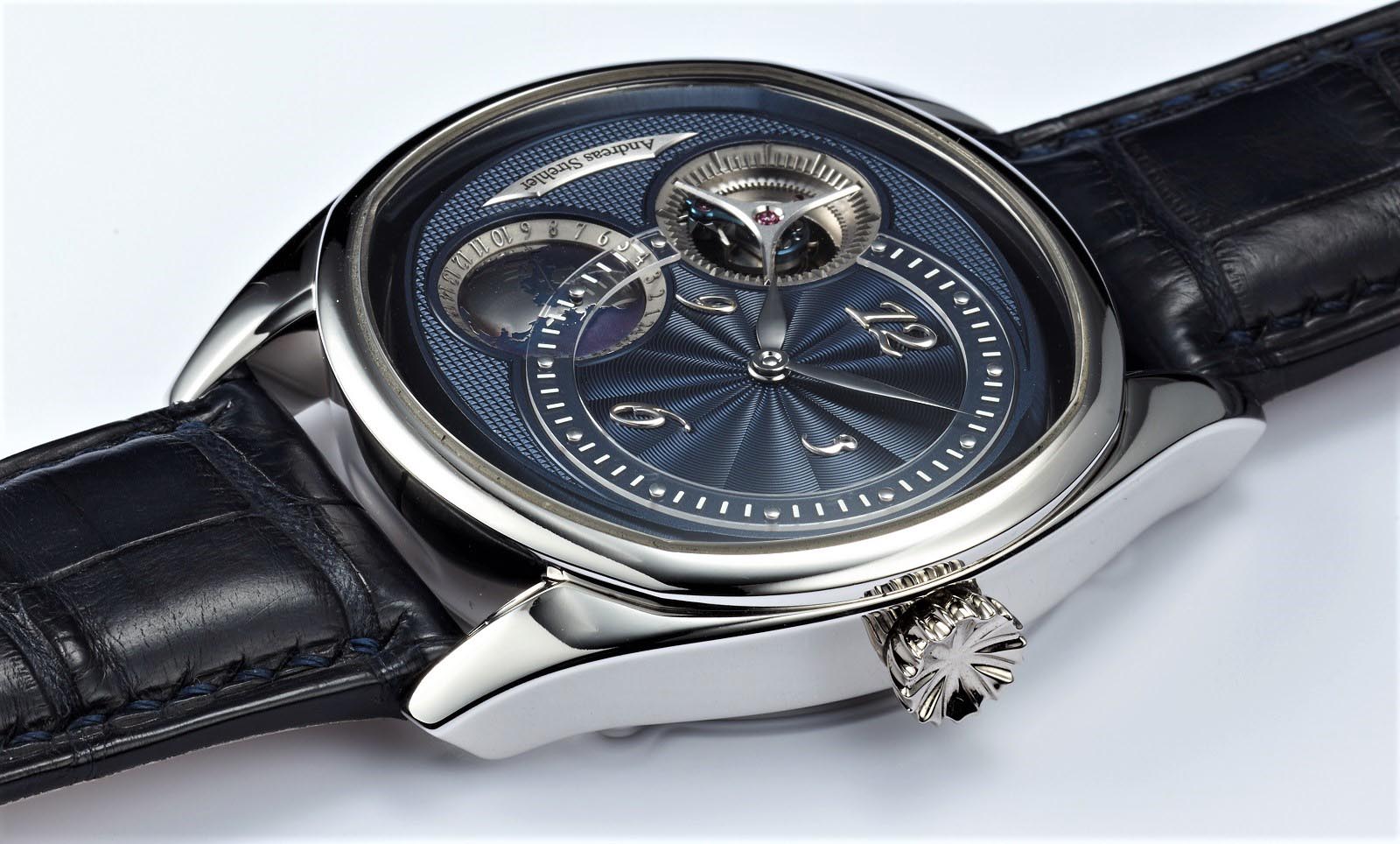
I am a collector of world time and time zone watches, and own several from mainstream brands. I had long had my own ideas of an ideal travel watch, and this is the tale of how one came to be.
A world time watch should simultaneously show at least 24 time zones on the dial. There are principally three dial types that can do this: first is a map of the Earth with time zones marked out; second is a disc with 24 reference time zones indicated by city names; third is a 24 hour ring in conjunction with a ring of reference time zones, widely known as the Cottier world time, after Swiss watchmaker Louis Cottier who built the first wristwatch with the mechanism.

Top row, from left: Lottermann & Söhne Weltzeituhr 1, Tissot Heritage Navigator, Patek Philippe ref. 5230G
Bottom row: Dubey & Schaldenbrand Weltzeit, Junkers 6892-5 Serie Worldtimer, Jean-Mairet & Gillman Sport. Images – respective brands
The first two variants use the entire dial to display world time, leaving no room for additional complications. The Cottier-system can as well dominate the design, with only the centre of the dial available for decorations or additional indications, making it difficult to embellish the dial with motifs relating to a specific brand. Reducing the displays can create a more interesting dial layout, but this results in microscopic indicators that are hardly readable.
For this reason, I now prefer time zone watches with only one additional zone time shown on a 24-hour scale, often labelled a “GMT” watch. But I do also like to have a reference for setting the second time zone, to match the time zone to the location. That spares me having to remember the time zone offset of a particular place.
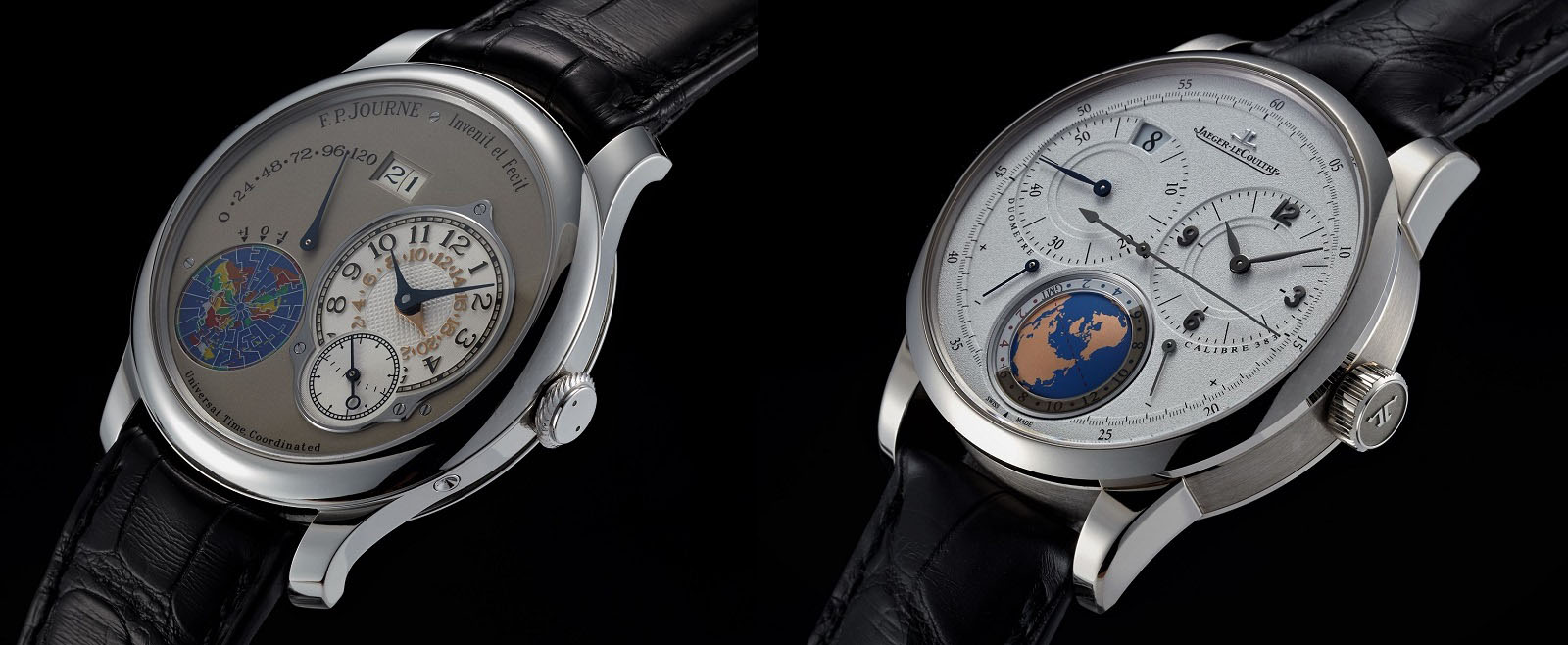
The F.P. Journe Octa UTC and Jaeger-LeCoultre Duomètre Universal Travel Time from the author’s own collection
F.P. Journe accomplished that with the Octa UTC, albeit with a tiny map to set a second time zone display. And Jaeger-LeCoultre’s Duomètre Unique Travel Time offers a construction allowing to set a second time zone to the minute.
Nevertheless, I long dreamt about a watch combining such a second time zone display with a world time indication in a legible manner. Andreas Strehler was one of the watchmakers I approached for such a watch (the other watchmakers I commissioned watches from will be detailed in future articles).
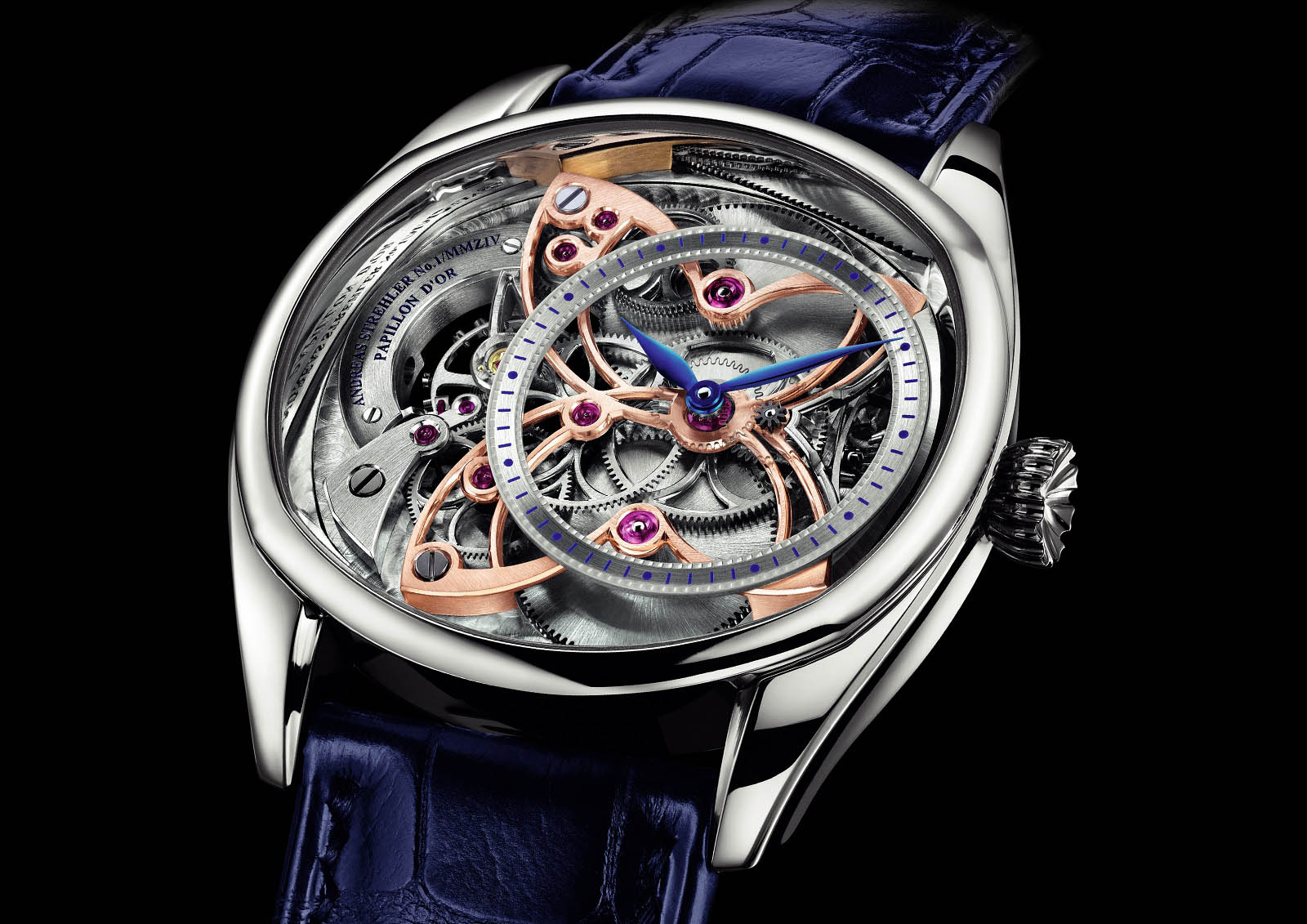
Papillon d’Or. Image – Andreas Strehler
I approached Andreas Strehler in the summer of 2014 when he was doing guided tours of an exhibition of watches made by AHCI members that was taking place in the watch museum within the famed Beyer watch store in Zurich. He expressed interest in my idea and promised to get back to me with an idea as soon as possible.
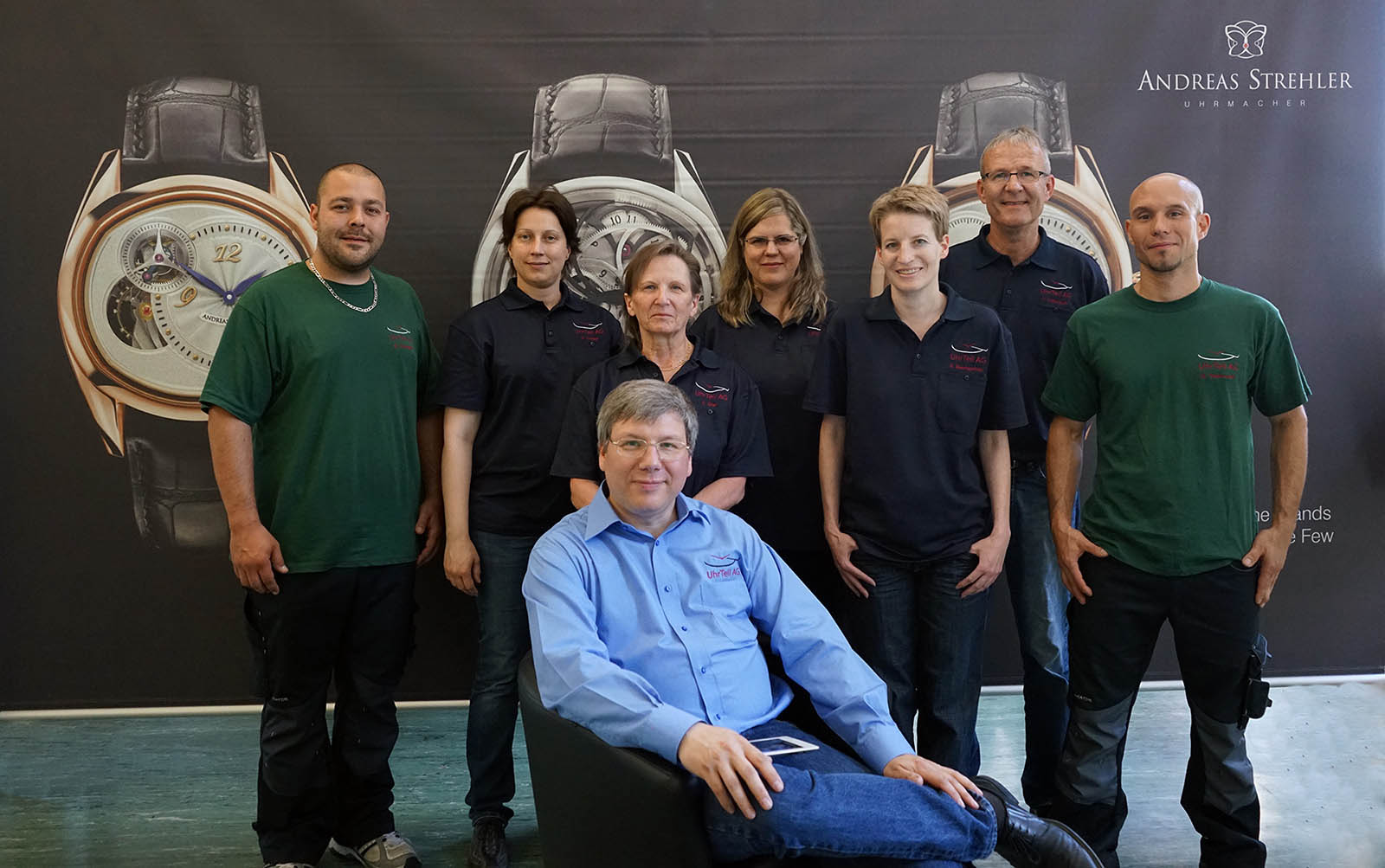
Andreas alone is involved in constructing and building the watches bearing his name; his employees are responsible only for the production of components. Photo – Andreas Strehler
What makes a Strehler watch
When enthusiasts discuss the independent watchmakers, Andreas is often forgotten. Members of the watch industry see this differently. Andreas is now one of the go-to specialists for movement construction and parts production – a watchmaker’s watchmaker. His company, Uhrteil, works for a diverse range of brands, including H. Moser & Cie.
Renaud & Papi had hired him as its first employee right after he graduated from watchmaking school. He found in Robert Greubel a generous patron, who not only put his vast library at Andreas’ disposal, but allowed him to borrow a computer with bespoke construction software. Andreas’ spare time was henceforth mostly spent eagerly learning how to construct watch movements.
To have both the hands-on experience of a watchmaker and the ability to construct movements is a huge advantage for Andreas. For example, he understands every part in a watch needs the tightest tolerances possible with the equipment used to make the parts, but for different reasons. The dial and base plate can have the same dimensions, but the positions and dimensions of the drilled holes are crucial for the plate, while the aesthetics are more important on the dial.
Without the experience as a watchmaker, which he also gained from restoration of vintage timepieces, there is a risk of constructing mechanisms unnecessarily expensive to build. A constructor might specify dimensions to overly narrow tolerances, what makes no sense when only space without dimensional function is required in a component, making assembly far more complex. Sometimes it makes just more sense to engineer generous tolerances instead of obliging the watchmaker to adjust every small detail.
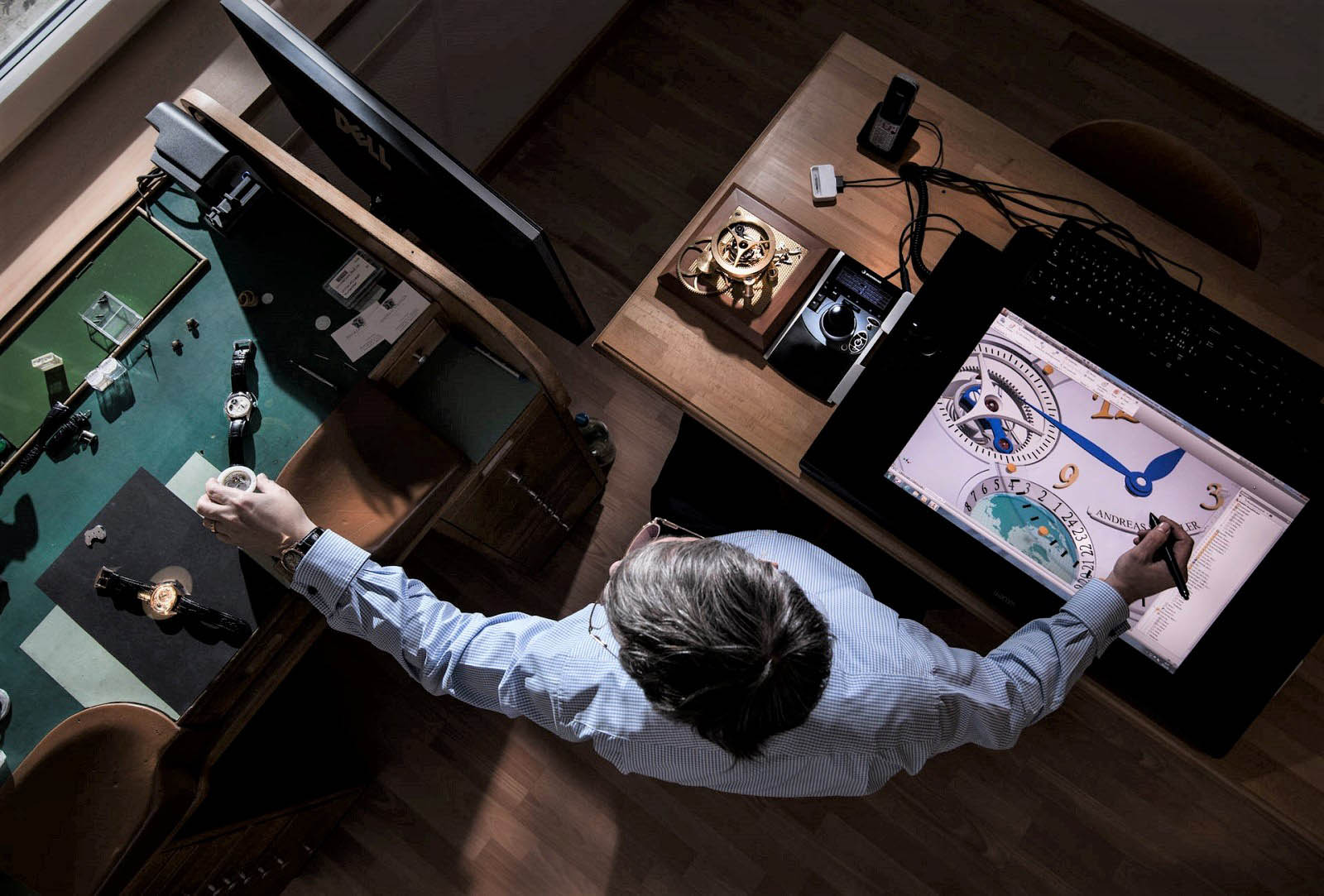
Andreas at work. Photo – Fondation de la Haute Horlogerie
Today, Andreas is confident enough to offer his industry customers video conferences when working on movements, relying on an overhead camera that looks right onto the computer screen, allowing his clients to follow his constructions in real time.
But he also produces watches under his own name, including bespoke and custom timepieces, that are destined for collectors. At the same time, enthusiasts can commission their own watch from scratch with unlimited options.
I didn’t want every part created for me, instead I wanted one of his existing models adapted to my requirements. To fulfil my goals, Andreas had not only to retain all the existing technical features of the watch, but to integrate a time zone as well as a world time mechanism into the movement, without increasing the size of the case.
Styling the Strehler case
Andreas’ unusually shaped case is difficult to appreciate in photos; the subtle curvatures of the fully polished case could be appreciated only when I held one of them in my hands. But only after Andreas himself explained the design did I truly grasp what it is about.
The cushion-shaped case, which Andreas uses for all his watches, is based on his love of Art Nouveau. Started at the end of the 19th century, the movement aimed to restore quality – of production and design – to ordinary objects used in daily life.
Often inspired by the forms of nature, Art Nouveau sought to move away from the cluttered style and composition favoured by industrialised mass production that was becoming dominant at the time. Thus the movement was particularly prominent in decorative and graphic arts, as well as architecture.
Andreas always loved the Art Nouveau’s flowing lines and shapes, which often took precedence over colour, explaining many of the forms in his designs, including the leaf-shaped hands. But working with subtle lines and contours is exceedingly difficult and usually requires a lot of tweaking to create an ideal design.
When Andreas showed me the dozens of case illustrations – each differentiated from the other by finely nuanced lines – created by the designer Laurent Auberson, I simply could not make out the difference between all of them.
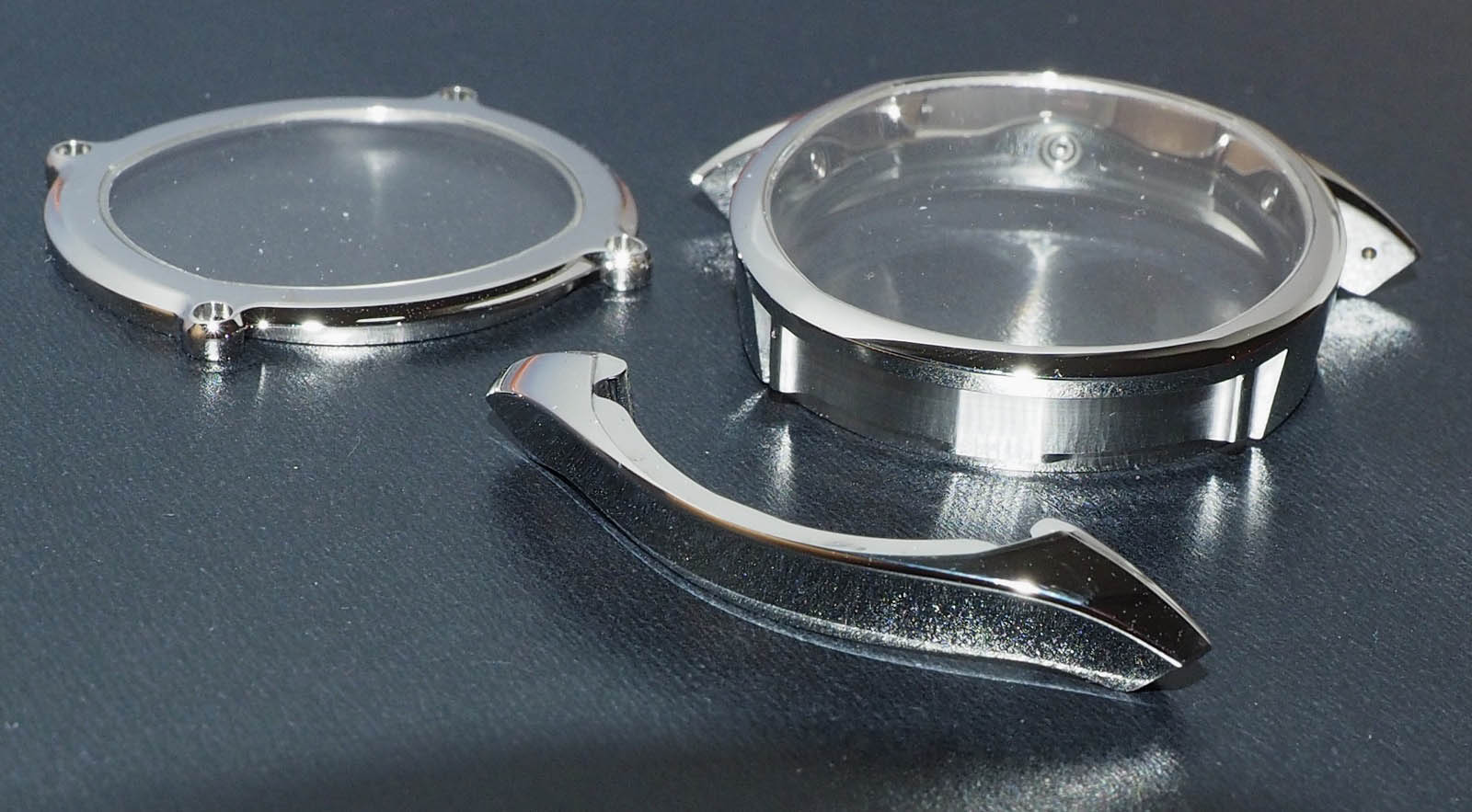
The unusual construction of the Papillon case. Photo – Andreas Strehler
But Andreas is both a constructor and designer, so practical considerations are an important part of his design ethos. The watch case is a complicated construction requiring manufacturing to the tightest of tolerances.
Andreas’ design of the case was not just aesthetic; he incorporated removable, “slide-on” lugs that also form the flanks of the case. That ensures easy accessibility to all parts of the case for refinishing during servicing, allowing for polishing without destroying the lines of the case, particularly important since the case design incorporates both convex and concave contours.
The Strehler movement
Andreas’ thoughtful, practical approach continues with the movement. Andreas wants absolute freedom when constructing movements, particularly to design gear train best suited for the intended purpose. For this he works not with a traditional base plate, but a central plate that is fully utilised on both sides.
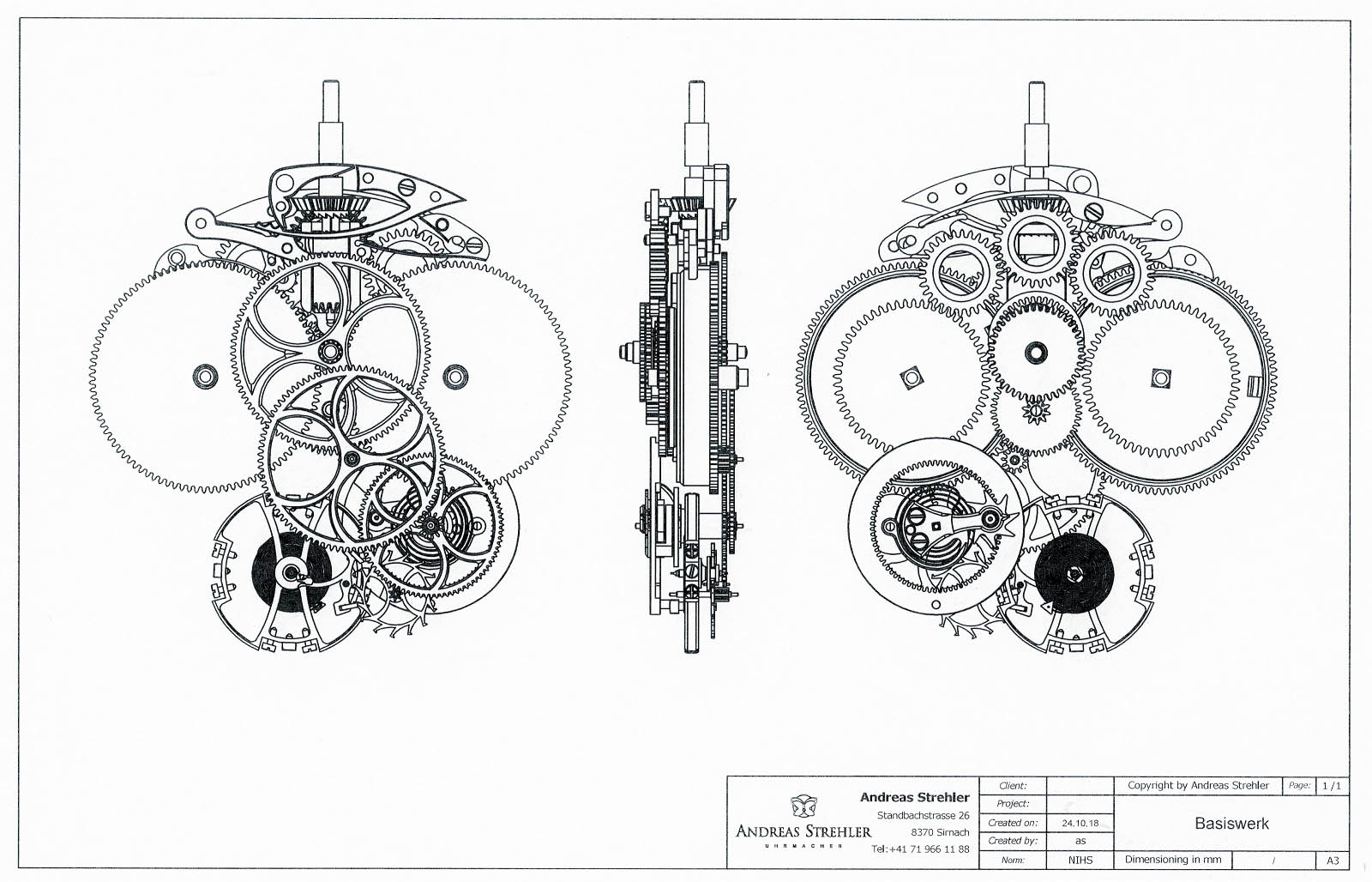
The moving parts of the Strehler movement, including the barrels, going train and escapement, which sit on either side of the central plate. Diagram – Andreas Strehler
Doing away with small bridges and instead mounting gears to a central plate also makes a movement much more resistant to incompetent handling. Every small bridge can be the source of tiny tolerance errors when reassembling a movement after servicing, which cumulatively add up to big problems within the gear train. When the tolerances are absolutely dictated by the central plate, such problems cannot arise.
The drawback is a much more elaborate movement plate. But because he produces it in-house, achieving the critical tolerances are not problematic. The resulting movement architecture is possibly unique.
He detests small parts, particularly when secured by tiny pins in sub-assemblies to create larger components. Therefore, the movements he constructs for his watches mostly use large parts arranged in an elegant way, which also uses the available space most efficiently.
A key feature of his watches is a two-mainspring movement with twin barrels connected in parallel, providing a power reserve of 78 hours. Because the twin barrels together exert less force than a single barrel with the same power reserve, the construction completely eliminates stress on the centre wheel and contributes to a much higher precision by avoiding stress on the pinions. So the unique form of the watch case is not just a fancy shape but also dictated by the movement’s layout and the compact construction.
Objects should always be elegant without impairing functionality, believes Andreas, a philosophy that influences the movement design of his watches. What he wants to achieve is a “living organism”, in his words, and not something coldly mechanically; in some ways this runs contrary to the hyper-technical styling of watches that’s been in fashion in recent years.
For instance, Andreas wants his gears to be as big as possible, while also being light, with unnecessary material trimmed away. Combined with minimalist and curved bridges, an architectural feel is created within the movement, sometimes making it difficult to differentiate gears from bridges.
That approach led to a bridge layout resembling a butterfly. The butterfly’s wings have elements looking like the stained-glass windows popular in Art Nouveau. He decided to accentuate the shape to emphasis the butterfly form, and finally named the watch Papillon, which is French for “butterfly”; the shape also now forms his company logo.
The attention to detail extends also to finishing, but again it is done to Andreas’ own tastes. Filigree bridges and gears with circular spokes create not one or two token interior angles in the movement parts, but 105 of them! All are refined by him personally, not with a file, but using a burnisher (essentially a steel rod with a wooden handle), followed by hand-polishing.
Leaning more to aesthetics favoured by engineers, he is not keen on the most fêted anglage with showy wide chamfers. Instead, bevels and flat surfaces of parts have to stay in proportion to each other. The hand-polished bevels in his movements are therefore narrower than on most haute horlogerie watches, but accentuated visually by the contrasting circular graining on all the flat surfaces of bridges and gears. Similarly, the circular graining is done by hand, with the part fixed in a tripod vice, exposing only the flat surfaces that require finishing.
Andreas also considers it important that some parts are unseen. The gears that do not fit into the overall architecture picture are rendered almost invisible by making them out of sapphire crystal. The result of all these aesthetic considerations is a unique movement.
Every detail in Andreas’ watches is executed the way he wants it, without the interference of clients or, god forbid, a marketing expert. There is only one concession that Andreas allows as an option for conservative collectors: covering up the organic movement construction with a traditional dial, which was my choice as I wanted to retain the dial as a canvas for decorations.
Andreas’ produces his own dials in-house by milling them out of sterling silver blanks. He constructed his dials so that they are secured by screws instead of feet – the tiny pins found on most dial – which are usually the first bits to bend or break off.
And because the dials are untreated on their sides, the unvarnished parts eventually tarnish, but again that has been factored into the construction. Should the tarnish become visible on the wrist, cleaning and restoring the dial to new is easy since there are no printed elements on the dial at all; everything on the dial is applied and removable.
All these features I desired are found in the Sauterelle à Lune Perpétuelle. Thus, it was the starting point for my bespoke creation.
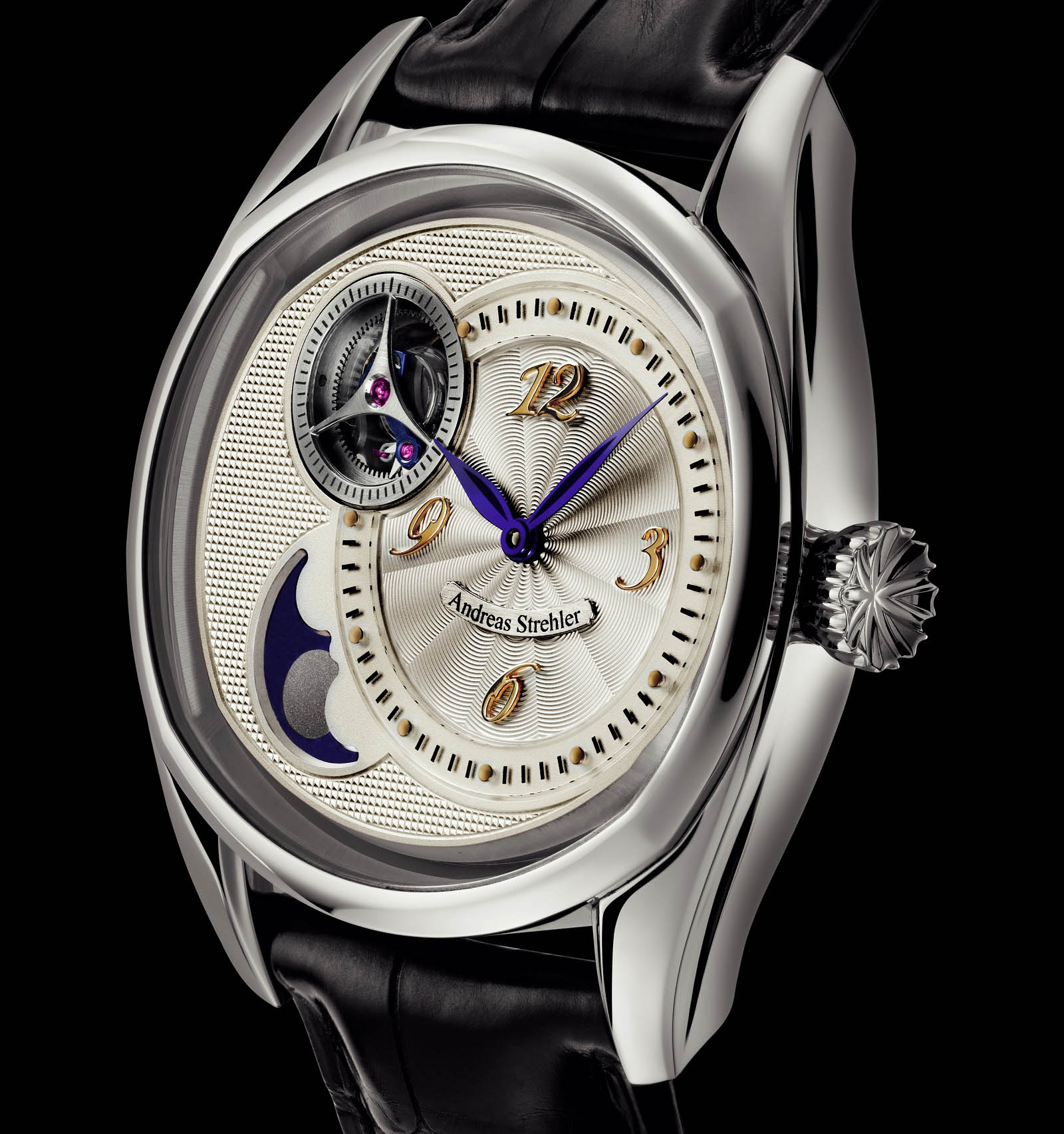
The Sauterelle à Lune Perpétuelle. Photo – Andreas Strehler
Spec’ing the watch
Two mechanisms invented by Andreas were important to have in my watch, being signature complications of his brand.
Since the remontoir d’egalité is a speciality of Andreas, I know this feature had to be retained. A constant and linear supply of energy to the balance is the basis for precision, and to achieve that, Andreas completely uncoupled the escapement from the gear train.
He placed the constant force mechanism on the seconds wheel (or fourth wheel). Here, the torque is taken from the mainspring and uses it periodically to re-wind a smaller, lighter spring close to the escapement; every second the satellite gear supplies the escapement wheel with exactly the same amount of energy (and at the same time the deadbeat or jumping seconds are indicated).
Andreas prefers this solution to the other favourite constant force mechanism, the chain and fusee. “Due to its construction with a defined fusée spiral, the chain-and-fusée only compensates a theoretical variation of the torque of the main spring but not the power variation of the real mainspring, friction variations, influences from complications, and so on,” he says, “These factors can only be compensated by a remontoir, situated immediately before the escapement and acting like a filter.”
The other must-have complication was Andreas’ record-setting moon phase indicator.
Phases of the moon in most watches are displayed on the basis of a 29.5 days cycle, which results in an error of one day in 2.5 years. This relies on a gear with 59 teeth that turns one step forward every day, much like a date indicator.
But the average lunar cycle is 29.530588 days, and Andreas wanted to represent this ratio with his watches. His solution is a continuously moving moon phase display. In comparison, typical moon phase discs are driven by a finger, in order to save space and allow quick corrections via a pusher.
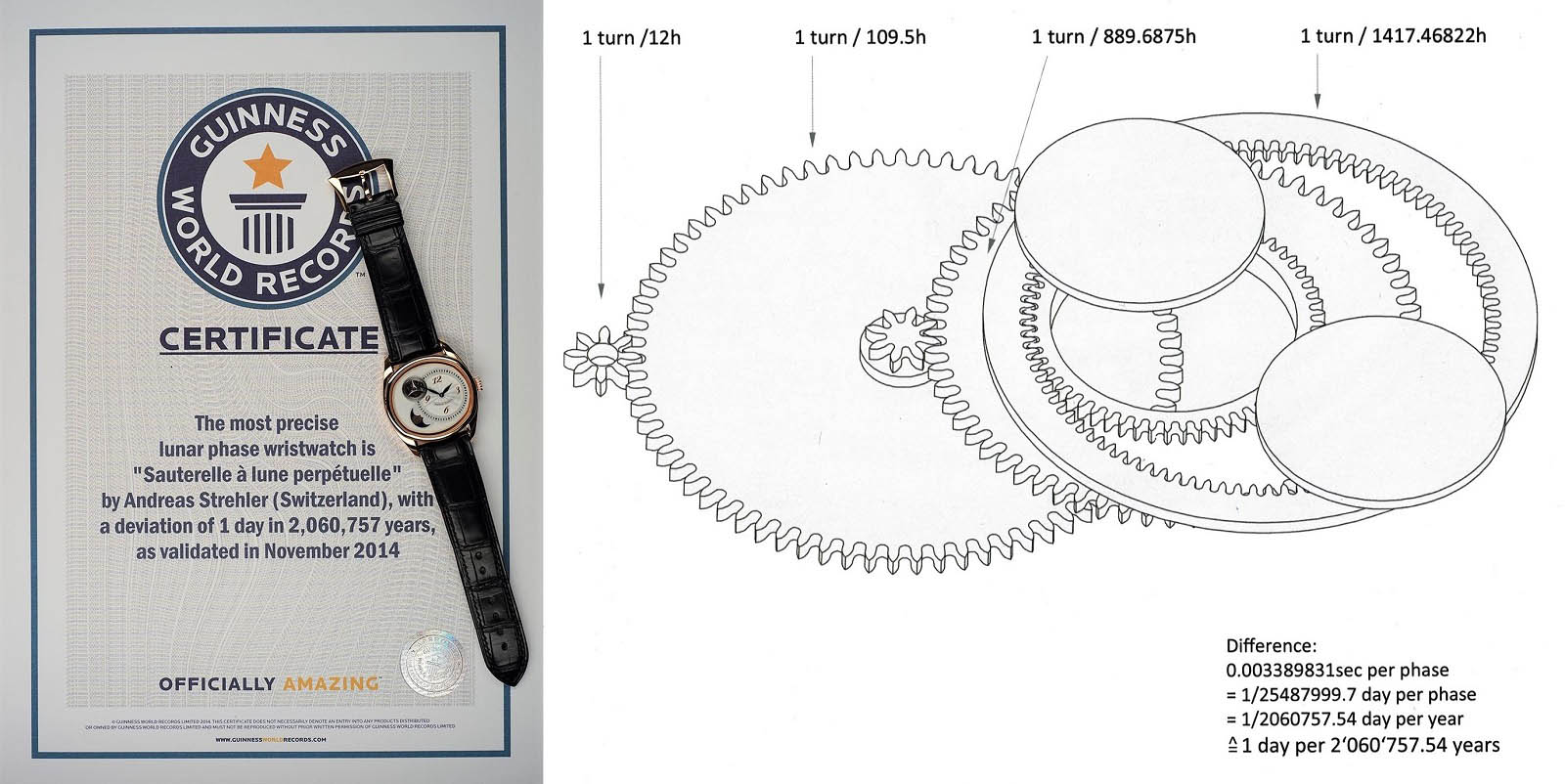
The gears that make up the record-setting Strehler moon phase. Diagram – Andreas Strehler
To achieve a precise gear ratio that matches the lunar cycle, is a major mathematical exercise in finding the correct combination of meshing gear train teeth, ideally reduced to sets of prime numbers. Andreas obtained one such solution, but the required gear tooth ratios necessitated large gears. Thus for compactness, he had used an internal ring gear to drive the moon phase disc instead.
Ultimately, the calculated moon phase error of only one day in 2,060,757 years earned an entry in the Guinness Book of Records that stands till today.
The draft
I visited Andreas at Baselworld 2015, where he showed me an illustration of his solution to my request. It was a travel watch that indicated a second time zone with an additional hour hand alongside a day/night display and moon phase. Two well-known watches with the same display are the Patek Philippe Calatrava Travel Time and the Jaeger-LeCoultre Master Hometime models.
Even though setting the additional hour hand with the help of a cities disc on the back of the watch was mentioned as part of the design, I was a bit disappointed because I expected a more elaborate solution from him. This proposal was not quite my dream watch.
But should an enthusiast like the idea of such a travel time watch, everything is in place to build the watch. Andreas enjoys constructing movements so much that he finished the development of the watch despite me deciding to go with something else. It’s also worth noting that a key advantage of the travel time specification is that the glorious movement and its finishing is fully visible on the back.
Three months after our meeting at Basel, I attended the open day of Uhrteil in Sirnach, located a 45 minutes’ drive from Zurich. Within this short time, he had created a completely different watch that was already available for perusal as a detailed CAD rendering.
Replacing the moon phase, he installed a world map that rotates once every 24 hours to display world time. And on the back, a disc with reference cities was used to set the hour hand in one-hour steps. Now this is what I wanted.
With a handshake, we agreed on a price, to be paid in three near-equal instalments – before production, once production started, and on delivery. Only the most basic specifications of the watch were mentioned in the order, the entire commission was based on trust and the belief that certain details, particularly the decoration, would be settled on the go.
I was still slightly disappointed at this stage, specifically, about the loss of the record-setting moon phase indication for space reasons. But two days later I got a very pleasant surprise.
Andreas wrote that he immediately returned to the drawing board after the last visitor had left, and he found a way to integrate the moon phase on the back of the watch. At the end of the process, no additional charge for this substantial modification showed up on the invoice, which reinforced my impression of Andreas as a true gentleman.
Designing the dial
All of my cars are free of any badge aside from the brand logo, and likewise, “GMT” on the dial had also to go. Experimenting with smaller numerals on the photocopier and cobbling something together with glue, I wondered if smaller versions of the “3” and “9” would work and balance the dial. Andreas liked the idea and refined it for the production watch.
The slightly domed, laser engraved steel disk showing the Northern Hemisphere gives the impression of a globe on the dial. Flame blueing gave colour to the seas, with the continents highlighted by a polishing that removed the thin blue oxide layer, creating a contrast in colours.
With suitable markings, the 24-hour disk is useful for home time. The proposed labelof “GMT”, instead of a more specific location made sense to me; my home time is only one hour off Greenwich Mean Time.
The view of the Northern Hemisphere found on Wikipedia, done in a style known as an orthographic projection, was chosen for the map. I like this for its balanced depiction ofland and water.
Incidentally, a graphic illustration cannot be directly converted into a laser engraving software template. An illustration is printed with a multitude of dots, so the lines are always slightly fuzzy at high magnification. Andreas therefore redrew the map by hand using CAD software, with a graphics raster of 0.02mm.
This was not overly time-consuming for him; working with a stylus he managed to draw the template for the engraving programme in about an hour. That made more sense to him then trusting software to render the map, because only he could determine the reasonable compromise between resolution and accuracy.
To avoid surplus clutter on the dial, the clear sapphire minute track also delineates the border between day/night on the globe, leading to a small deviation from the customary 6:30am to 6:30pm distinction on most world time watches.
On the backside, the engineer took over, and Andreas first proposed a moon phase display using the cities disc as horizon for a technical and slightly naked look. I did not like it – neither Andreas in hindsight – and asked for a more traditional indication. The revised moon phase revision had the added advantage of revealing at least part of the signature butterfly-shaped bridge, which would have otherwise been covered by the travel time setting mechanism.
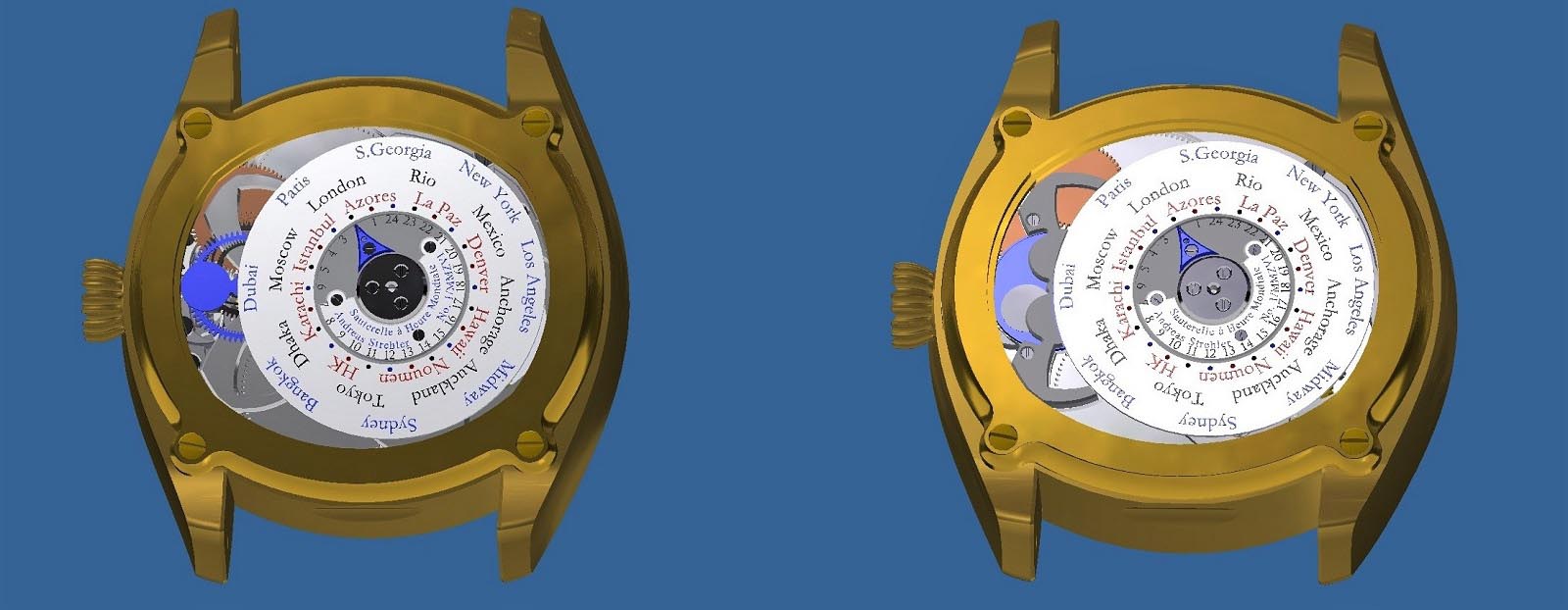
The original moon phase display (left) and the later design that shows more of the butterfly-shaped bridge
A lot of effort went into the graphic design of the cities ring on the back. Since I always require specific reference cities on my world time discs, the key question was how to arrange the city names, each of the vastly different lengths, for a pleasing, balanced look.
Andreas hired designer Michael Horlbeck to solve this problem and to suggest further elements, including colours, for better legibility. I stopped at specifying the font because there was only one solution in my mind: the typography had to be the same as Andreas uses elsewhere on the watch.
For the colours, another watch enthusiast brought up the idea of using the colours typically used in old maritime maps. Unfortunately, this failed to provide the contrast needed for legibility. This was an important issue, since Andreas wanted to incorporate the daylight savings indication using colours as well. In the end, the colour palette was the same as that used on the existing Lune Exacte watch, where it works well for the Vernier scale.
World time, GMT and Home time on the map
Because my watch has displays on the front and back, the main problem in constructing the movement was to transfer the required information from the main time and GMT display on the front, over to the back for the setting mechanism and the world time. The illustration below of the movement without its mounting plates and bridges showsthe impossibility of adding gears for the transfer of information with an indirect going train.
Andreas’ dazzling solution was to go straight through the arbour of the mainspring barrels (marked in white on the illustration below).
With the hand-setting and driving mechanisms on the dial side of the movement, the challenge was to communicate two angle inclinations to the back of the movement (including the position of the Earth map). At the same time the time data has to be reduced from a 12-hour to a 24-hour format, while ensuring the direction of rotation to becorrect, all while using a minimum of gears.
Richard Lee, the technical contributor to this site, adds his assessment and illustrations:
“There is slight resemblance to other world time watches that are adjusted via the crown. But the highlight here is the engineering approach, whereby Andreas has found ways to transfer the display from dial side to back, using a novel idea of having the shafts passing through the twin mainspring barrels. In addition, the complete integration of the GMT globe on the dial-side with the time zone selector on the movement side.”
“When the crown is pulled out once, the current time zone (local time) can be adjusted, as the hour hand snaps forwards or backwards in one-hour steps thanks to a jumper. Simultaneously, a selector arrow on the back of the watch also turns to indicate the new reference city. While this happens, the GMT globe on the dial remains stationary – changing your local time doesn’t affect the home time, or the rest of the world.”
“Both the red and blue gear trains are symmetrical, with identical gear ratios. Therefore, with the crown pulled out fully to adjust the time, both the city disc and the selector arrow rotates together at the same rate and stays in sync. Simultaneously, the GMT globe on the dial-side rotates accordingly as current time is adjusted.”
“There’s a certain aesthetic elegance to such a solution using two shafts passing right through the twin mainspring barrel, which preserves the movement’s lengthwise symmetry. This also further strengthens the Papillon motif – two halves of a butterfly’s wings.”
World time display and setting disc on the back
The reference city disc on the back turns once in 24 hours. By printing a 24-hour scale on the rear crystal, an additional world time display was created, supporting the parallel map display on the dial. The flame blued marker for the 24-hour disk can be set independently as a travel time indicator.
Moving the marker (via the crown) to another reference city moves the hour hand of the main time display in one-hour increments; a clutch on the hour-wheel makes the jumping action possible. The GMT marker on the map of the dial shows my home time, offset by one hour from GMT, when travelling.
To pack all these complications into a case of 41mm by 37.3mm, with a height of only 11.6mm including bezels and crystals, is a real achievement and requires a movement construction integrated to the highest order. There is no way to stay so slim by working with add-on modules that are so popular in the industry for their convenience.
Moon phase display moved to back
To move the moon phase display to the back did not challenge Andreas too much. The main issue was the necessary compromise required fittingthe biggest possible gears into the tiny available space to get the gear ratio needed for the ultra-accurate moon.
The hour-wheel meshes with the gear of the moon phase, and gears receiving the information for the 24-hour display also power the moon disc.
The moon phase is set by moving the hands of the main time display. No quick-setting mechanism was integrated, which would have further competed for already scarce space inside the case. This is fine for me, because the watch does not get wrist time for continuous running. I admit each time I wear it, I am too lazy to set the moon phase, which I like mainly for the decorative effect. Should I need the exact age of the moon, Stepan Sarpaneva’s app is on my mobile phone.
An extension of the “butterfly” bridge creates the moon horizon. This bridge is a feast for the eyes with its many beautifully detailed interior angles, but unfortunately the splendour is mostly invisible on the assembled watch, since it is covered up by the time zone setting disc.
For Andreas, the biggest problem unfolded with the intensive use of the setting mechanism. Adding further functions – all set through the crown – could lead to a very slight creaking occasionally occurring when the world time was being set, with the risk of some play or “float” in the hour hand on the dial.
The cause was found in the complicated winding mechanism, where external teeth have to mesh with internal teeth of different tooth geometry. The meshing could not be forced due to the danger of blocking and damaging the whole mechanism. While others might have left the construction as it was, for Andreas it was unacceptable. He reconstructed and produced about 30 parts anew, including the movement plate, just to solve this problem.
The solution is an elaborate latching and shuttle mechanism. Unlike a conventional keyless work, an additional shuttle is introduced which houses the keyless clutch within. The position of both parts is controlled individually by two separate levers, in turn actuated by the position of the crown. This allows three distinct modes of operation via the crown’s position – for winding the barrels, adjusting the time zone, and adjusting the time.
All this is done to allow the use of an idling pinion, which is mounted on the shuttle. It serves as an intermediate gear that facilitates smoother meshing of the gears when turning the crown.
Meanwhile, a tiny latch – only 2.2 mm in length – is installed out of necessity during time zone adjustment. When the crown is pulled out once, the shuttle is “floating”, and only held back by a detent spring. As the gears only mesh loosely, the teeth will skip if the crown is turned. Therefore, the latch locks the shuttle in place to solve this problem.
When the crown is pulled out further for adjusting time, the shuttle is unlocked and is firmly pushed inwards by the shuttle lever, allowing time setting.
Moving to the exterior decoration, I was able to make some choices. Customers can order whatever guilloché pattern they want. Samples are not shown as computer renderings, but made in brass. Andreas claims to be more proficient in programming a CNC mill than drawing graphic illustrations, so physical samples are easier than drawings.
When I asked about the unusual creamy white colour of my dial, I learnt it is a reference to historic dials that were never in the bright white mostly used today. But the plate for the brand name is in stainless steel. This is another contribution to the longevity of his watches, because the sterling silver plates he used in the past were easily scratched if special protection was not applied.
Andreas creates the guilloché with a CNC milling machine. He has long had ambitions to construct a machine combining an electronic control of the ratchet setting wheels with a traditional graver worked by hand, but has never found the time to do so.
I believe that would be a wasted effort. The production tricks he uses render his guilloché indistinguishable from hand-turned versions.
To start with, a milling tool with a pointed but rather flat tip leaves almost no telltale marks of the production method. Engraving a slightly deeper groove around the edge of the area with the guilloché pattern removes the final traces of CNC milling.
Perhaps the only clue to the CNC technique is the small, rounded terminal end at the bottom of the engraved line, whereas hand guilloche would have a sharp line with diminishing depth.
When I look at Kari Voutilainen’s hand guilloché work, I realise he also engraved a “border groove” by CNC to finish the guilloché areas. Striving for this perfection closes noticeable differences in between hand and machine work.
While Andreas likes grain d’orge, or barley corn, guilloche for the dial, particularly with the diminishing scale of the motif towards the centre of the time display, I preferred the combination of Clous de Paris, or hobnail, with a sunray pattern. The latter looks more elegant and interesting to me than the uniform pattern of grain d’orge.
Andreas wants the individual hobnails of his guilloché to be a very specific shape – the hills must be quite high and pointed, with the peak just ever so lightly decapitated to create a tiny flat plain.
Other parts of the dial, like the flat areas around the guilloche, are blasted with glass beads to create a frosted surface for contrast. The sapphire ring of the minute track is laser cut, the indices printed and the inserted 5-minute markers as well as the numerals are wire-eroded from 18K yellow gold.
Even though the two dials that were made for my watch have similar Breguet numerals, the anglage of the appliqués is different, illustrating the infinite details Andreas considers.
He deemed softer, more rounded interior angles more suited to the white dial, but sharp edged angles a better match for the more modern look of the blue dial with rhodium-plated numerals. I can only agree, and I am glad the watchmaker thinks about such details that would never have crossed my mind.
Andreas’ detailing of parts is so delicate it can be difficult to discover it without explanations. The feuille steel hands belong in this category. From a distance, the difference between stamped, off-the-shelf hands are difficult to perceive.
However, these hands are an example of the extravagant efforts he expends for perfect results. The hands start with milling a sheet of steel to the required thickness. The hands in their rough state are cut from the sheet by wire erosion. Then they are tempered, then milled on a lathe to cut the chamfers around the centre.
Pure handwork follows: the surface curvature is created by filing and sanding; the underside is also sanded to remove all work traces; and the chamfers and top surface are mirror polished. To enhance this polishing work with some contrast, the tiny vertical surfaces on the side of the hands get then a fine brushing. That’s followed by an intensive cleaning, and then the bluing of the hands.
Bluing is done on a bed of brass shavings that is heated with a gas cigarette lighter because this turns out the easiest way to control the temperature. After that, the surface around the centre is flat polished on a tin plate covered in diamond paste.
Bespoke detailing
With such commissions I never ask for exclusivity, or a true unique piece. The goal of such endeavours is to create a watch that matches my dream specifications exactly, while also to have a creation by a master watchmaker that fits my collection with its specific theme.
I get no pride of ownership by excluding others to have the same. This attitude relieves my finances quite a bit since the watchmaker can use his ideas on other watches to amortise the cost of development.
Instead, I like personalised, unique details, like the moon phase for instance.
I wanted the moon discs to replicate the moon surface – it was a small detail but a big job. Andreas found a Bitmap template of a good NASA photo showing the lunar surface, and turned it into a template for laser engraving.
If you have more than one depth in the engraving, every single beam point has to be programmed for the laser. Fortunately, the laser-engraving specialist was willing to spend the time to do it perfectly and include all the different depths points to turn the NASA photo into a 3D structure.
The moon disc consists of four parts: the principal disc is flame blued steel, with two solid 18k yellow gold moon discs press fitted. These parts are then inserted into a steel gear ring with internal teeth.
Having found a reliable specialist for laser engraving, Andreas offered to change the printing of the scales to relief numbers, and also replacing brass with steel. Accomplishing that was more complex than it sounds.
The remontoir plate and bridge are in brass and appear through an aperture in the dial in the standard version of the watch. Brass cannot be sculpted by laser, being too soft. So Andreas had to build a new dial with a bigger hole aperture.
Furthermore, he constructed, via wire erosion and then hand finishing, a steel ring carrying the relief-engraved scale and a hand-finished steel bridge for the remontoir, each a separate part that was inserted into the dial.
The same was done for the relief scale around the map, which is no longer a part of the dial, but a distinct steel part.
For the time zone setting disc at the back, skeletonizing; distinct, concentric rings; and flame bluing replaced the multi-coloured markings.
Here the different colours of the stock version were replaced by relief engraving and skeletonised a newly made steel component. The laser engraver was unable to do all of that with standard techniques, so Andreas devised a process and then taught the laser engraver how to do it!
Business ethics and communication
In my experience, such projects can only be successful when they can be based on mutual trust and excellent communication. Andreas had already earned my trust when I first met him in the Beyer Watch Museum in 2014. Seeing how enthusiastically he explained the watches of his AHCI colleagues to visitors, without giving any hints as to which watches on show were his, I was deeply impressed by his unselfish attitude.
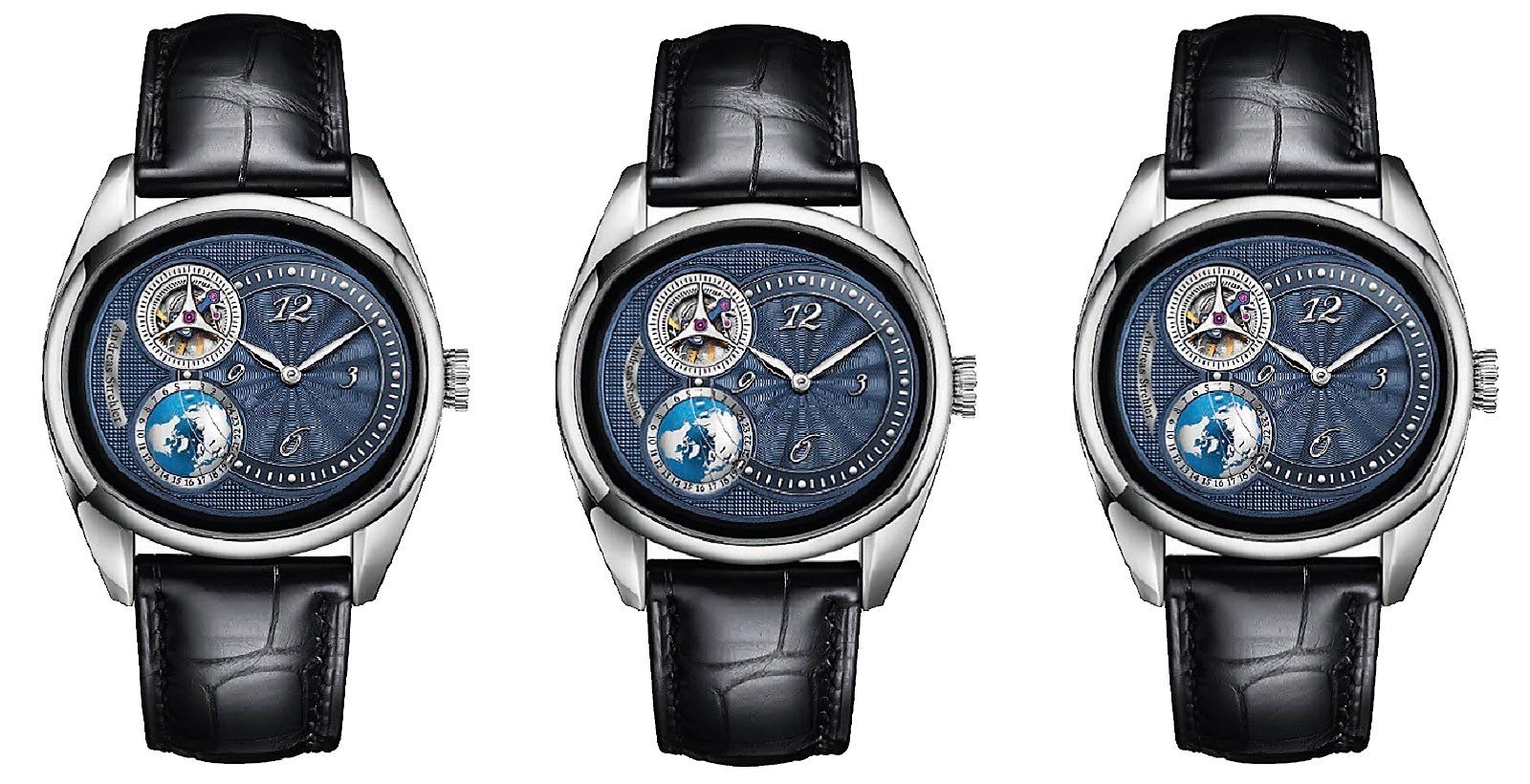
The shape and position of the name plate on the dial can make a big visual difference, which is why mock-ups are so valuable
Through emails and particularly CAD illustrations as well as photos he kept me always updated. He engaged designer Michael Horlbeck to provide detailed illustrations, offering choices for the dial. When questions came up, Andreas answered them usually on the same day with all the required, or even extra, details.
I particularly appreciated his patience. More or less starting from scratch in this project, he was forced to find new suppliers and even teach them a suitable technique to get the best possible results with all the laser engravings and other design details.
Without someone taking such a personal interest in understanding and converting my ideas into reality, I cannot imagine how a watch like I got could have materialised. For me, such projects cannot work without direct access to the final decision maker, who has also to be the constructor/watchmaker for the discussions about the feasibility of ideas.
Andreas is particularly proud of his parts production capability. That makes almost everything possible and the customer does not need to compromise his desires as a result of limited production possibilities or employee skills. Conical gears, for example, are rarely used elsewhere despite their technical advantages because they are difficult to produce, but Andreas does them in-house.
The result
It took 39 months from the first instalment to the finished watch, but that was entirely due to me. The watch, with its new movement inside, was ready after less than two years. The additional time was spent to develop and create all the bespoke elements I asked for. I believe this time by was well spent – there is no point in ordering a bespoke creation and not maximise the opportunities – in order to get the perfect watch.
For the time being I am wearing the watch with the blue dial. The subdued elegance fascinates me. But the colour means also only seasoned watch aficionados will notice it.
While the white dial is easy to read, the blue dial is different. Depending on the light, the polished hands can sometimes hide in the reflections of the soleil guillochéof the blue dial. No legibility problems exist with the setting disk on the back.
Winding the watch requires quite some torque, but it gives a completely different feeling to other watches because there is absolutely no recoil. The pleasure of winding a manual movement is slightly curtailed by the sculpted crown that is on the small side.
When collecting a watch from Andreas in person, you will not be offered a glass of prosecco, but are instead invited to sit down with him to assemble the watch box together.
A supplier makes the hinges of the box, however, the lock is produced from steel and brass in his own workshop. The female part of this lock has a special cutting thread so that no predrilling of the hardwood box is necessary, since that could be a source of unwanted tolerances. There is even a custom-made tool to ensure precise fitting of the lock.
For me, this makes a huge difference in buying a watch from the display case in a store, no matter how luxurious the furnishing. Creating a watch for a specific customer requires regular communication, with the watchmaker disclosing many facets of himself in this process. This helps me to understand the watch better, and the sentimental value developed by working together is priceless.
Back to top.

